Study of the Spatial Distribution of the Bark Beetle in the Ejido Tixtlancingo
Abstract
1. Introduction
2. Materials and Methods
Host Trees
3. Methodology
3.1. Climatic Conditions
3.2. Spatial Poisson Process
3.3. Spatial Distribution Evaluation
3.4. Statistics Software
3.5. Correlation in Bark Beetle Damage
4. Results
4.1. Climatic Variables
4.2. Bark Beetle Damage, 2020
Spatial Interpolation
4.3. Bark Beetle Damage, 2021
Spatial Interpolation
4.4. Comparison
5. Discussion
6. Conclusions
Author Contributions
Funding
Data Availability Statement
Acknowledgments
Conflicts of Interest
References
- Díaz-Núñez, V.; Sánchez-Martínez, G.; Gillette, N.E. Respuesta de Dendroctonus mexicanus (Hopkins) a dos isómeros ópticos de Verbenona. Agrociencia 2006, 40, 349–354. Available online: https://www.redalyc.org/articulo.oa?id=30240307? (accessed on 5 January 2024).
- Armendáriz-Toledano, F.; Zúñiga, G.; García-Román, J.; Valerio-Mendoza, O.; García-Navarrete, P.G. Guía ilustrada para identificar a las especies del género Dendroctonus presentes en México y Centroamérica. In Red Temática de Salud Forestal; Comisión Nacional de Ciencia y Tecnología; Instituto Politécnico Nacional: Mexico City, México, 2018; Available online: https://www.researchgate.net/publication/327043016_Guia_ilustrada_para_identificar_a_las_especies_del_genero_Dendroctonus_presentes_en_Mexico_y_Centroamerica?enrichId=rgreq-81e308822f170b18d403f705e998771a-XXX&enrichSource=Y292ZXJQYWdlOzMyNzA0MzAxNjtBUzo2NjA3ODYwMTU5MDc4NDFAMTUzNDU1NTA3MTkzNg%3D%3D&el=1_x_2&_esc=publicationCoverPdf (accessed on 10 January 2024).
- Salinas, M.Y.; Mendoza Correa, G.; Barrios, M.A.; Cisneros, R.; Macías-Sámano, J.; Zúñiga, G. Areography of the genus Dendroctonus (Coleoptera: Curculionidae) in Mexico. J. Biogeogr. 2004, 31, 1163–1177. Available online: https://ipn.elsevierpure.com/es/publications/areography-of-the-genus-dendroctonus-coleoptera-curculionidae-sco (accessed on 10 January 2024). [CrossRef]
- SEMARNAT. Capítulo 5. Aprovechamiento de los Recursos Forestales, Pesqueros y de la Vida Silvestre. 2005. SEMARNAT, Dirección General de Gestión Forestal y de Suelos. Available online: https://apps1.semarnat.gob.mx:8443/dgeia/informe_resumen/05_aprovechamiento/cap5.html (accessed on 31 March 2024).
- Cuéllar-Rodríguez, G.; Equihua-Martínez, A.; Villa-Castillo, J.; Estrada Venegas, E.G.; Méndez-Montiel, T.; Romero-Nápoles, J. Análisis Espacio-Temporal de los Bosques de Pinus Cembroides Zucc. Atacados por Dendroctonus mexicanus Hopkins. Rev. Mex. Cienc. For. 2013, 4, 42–49. Available online: https://www.scielo.org.mx/scielo.php?script=sci_arttext&pid=S2007-11322013000300005 (accessed on 10 January 2024).
- CONAFOR, Comisión Nacional Forestal. Superficie Forestal Afectada por Plagas y Enfermedades Forestales. 2015. Base de Datos Estadísticos-Badesniarn. Available online: http://dgeiawf.semarnat.gob.mx:8080/approot/dgeia_mce/html/mce_index.html?De=BADESNIAN (accessed on 31 March 2024).
- Olivos Martínez, J.A. Diagnóstico fitosanitario para el Estado de Chihuahua, CONAFOR-SEMARNAT. Chihuahua 2021, 1–28. Available online: http://sivicoff.cnf.gob.mx/ContenidoPublico/02%20Informes%20de%20acciones%20operativas/DiagnosticosEstatales/2021/Chihuahua.pdf (accessed on 10 January 2024).
- Chown, S.L.; Nicolson, S.W. Insect Physiological Ecological: Mechanisms and Patterns; Oxford University Press: Oxford, UK, 2004; p. 243. [Google Scholar] [CrossRef]
- De la Vega, G.J.; Schilman, P.E. La importancia de la fisiología en la distribución geográfica de los insectos. Rev. Soc. Entomológ. Argent. 2015, 74, 101–108. Available online: https://www.researchgate.net/publication/288984836_La_importancia_de_la_fisiologia_en_la_distribucion_geografica_de_los_insectos_The_importance_of_physiology_on_insect_geographical_distribution (accessed on 10 January 2024).
- Clark, N. The effect of temperature y humidity upon the eggs of the bug, Rhudnius prolixus(Heteroptera, Reduviide). J. Anim. Ecol. 2019, 4, 82–87. Available online: https://www.jstor.org/stable/1215 (accessed on 10 January 2024). [CrossRef]
- Safranyik, L.; Carrol, A.L.; Régniére, J.; Langor, D.W.; Riel, W.G.; Shore, T.L.; Taylor, S.W. Potentitial for range expansion of mountain pine beetle into the boreal forest of North America. Can. Entomol. 2010, 142, 415–442. Available online: https://www.researchgate.net/publication/232686917_Potential_for_Range_Expansion_of_Mountain_Pine_Beetle_into_the_Boreal_Forest_of_North_America (accessed on 10 January 2024). [CrossRef]
- Rubín Aguirre, A.; Sáenz-Romero, C.; Lindig-Cisneros, R.; del Río Mora, A.A.; Tena Morelos, C.A.; Campos Bolaños, R.; del Val, E. Bark beetle pests in an altitudinal gradient of a Mexican managed forest. For. Ecol. Manag. 2015, 343, 73–79. Available online: https://www.sciencedirect.com/science/article/abs/pii/S037811271500047X (accessed on 10 January 2024). [CrossRef]
- Soto Correa, J.C.; Giron Gutierrez, D.; Cambron Sandoval, V.H. Coloración y abundancia de Dendroctonus mexicanus Hopkins, 1905 de cuatro regiones de México. Rev. méx. Cienc. For. 2020, 11, 163–184. [Google Scholar] [CrossRef]
- García López, A.; Micó, E.; Galante, E. From lowlands to highlands: Searching for elevational patterns of species richness and distribution of scarab beetles in Costa Rica. Divers. Distrib. 2012, 18, 543–553. Available online: https://onlinelibrary.wiley.com/doi/full/10.1111/j.1472-4642.2011.00846.x (accessed on 10 January 2024). [CrossRef]
- Bentz, B.; Vandygriff, J.; Jensen, C.; Coleman, T.; Maloney, P.; Smith, S.; Schen-Langenheim, G. Mountain pine beetle voltinism and life history characteristics across latitudinal and elevational gradients in the western United States. For. Sci. 2014, 60, 434–449. Available online: https://www.fs.usda.gov/research/treesearch/46019 (accessed on 20 January 2024).
- Six, D.L.; Bracewell, R.R. Dendroctonus. In Bark Beetles: Biology and Ecology of Native and Invasive Species; Academic Press: Cambridge, MA, USA, 2015; pp. 305–350. [Google Scholar]
- Sáenz-Romero, C.; Rehfeldt, G.E.; Crookston, N.L.; Duval, P.; St-Amant, R.; Beaulieu, J.; Richardson, B.A. Spline models of contemporary, 2030, 2060 and 2090 climates of Mexico and their use in understanding climate-change impacts on the vegetation. Clim. Chang. 2010, 102, 595–623. Available online: https://www.scielo.org.mx/scielo.php?script=sci_arttext&pid=S0187-73802012000400010 (accessed on 10 January 2024). [CrossRef]
- Chen, H.; Jackson, P.; Ott, P.; Spittlehouse, D. Análisis de patrones espaciotemporales de montañas potenciales. Emergencia del escarabajo del pino en Columbia Británica, Canadá. Ecol. Gestión For. 2015, 339, 11–19. [Google Scholar]
- Hart, S.J.; Veblen, T.T.; Eisenhart, K.S.; Jarvis, D.; Kulakowski, D. La sequía induce al escarabajo del abeto (Dendroctonus rufipennis) brotes al otro lado de noroeste Colorado. Ecología 2014, 95, 930–939. Available online: https://pubmed.ncbi.nlm.nih.gov/24933812/ (accessed on 10 January 2024). [CrossRef] [PubMed]
- Kulakowski, D.; Jarvis, D. Aumentan los incendios de baja gravedad susceptibilidad del pino torcido al escarabajo del pino de montañaBrotes en Colorado. Ecol. Gestión For. 2013, 289, 544–550. [Google Scholar]
- Windmüller-Campione, M.A. Evaluando el futuro susceptibilidad de montaña pino escarabajo (Dendroctonus ponderosae) en la región de los Grandes Lagos utilizando bosques composición y estructurales atributos. Can. D. Investig. For. 2018, 48, 451–459. [Google Scholar]
- Vázquez-Ochoa, F.; Reverchon, F.; Sánchez-Velásquez, L.R.; Ruíz-Montiel, C.; Pineda-López, M.R. Suelo Propiedades químicas y procesos biológicos bajo pino árboles con y sin Dendroctonus infestación por escarabajos de la corteza. Rev. Silvic. Sosten. 2020, 40, 371–384. Available online: https://www.tandfonline.com/doi/abs/10.1080/10549811.2020.1759103 (accessed on 10 January 2024).
- Morales-Rangel, A.V.H.; Cambrón-Sandoval, S.; Vergara- Pineda, A. Obregón-Zúñiga. Fluctuación poblacional de Dendroctonus frontalis Zimmerman, 1868 y Dendroctonus mexicanus Hopkins, 1909 (Coleoptera: Curculionidae: Scolytinae) y su asociación con variables climáticas en bosques de pino en el municipio de Landa de Matamoros, Querétaro, México. Entomol. Mex. 2016, 3, 633–638. Available online: https://www.researchgate.net/publication/323430830_FLUCTUACION_POBLACIONAL_DE_Dendroctonus_frontalis_Zimmerman_1868_Y_Dendroctonus_mexicanus_Hopkins_1909_COLEOPTERA_CURCULIONIDAE_SCOLYTINAE_Y_SU_ASOCIACION_CON_VARIABLES_CLIMATICAS_EN_BOSQUES_DE_PINO_E (accessed on 10 January 2024).
- Leal, O.N. Fluctuación Poblacional de Dendroctonus Mexicanus Hopkins y Variación Estacional de la Temperatura y Humedad Relativa, en San Juan del Estado, ETLA; Colegio de Postgraduados: Oaxaca, México; Edo: Ciudad de México, México, 2014. [Google Scholar]
- Perez-Miranda, R.; González-Hernández, A.; Velasco-Bautista, E.; Romero-Sánchez, M.E.; Arriola-Padilla, M.J.; Acosta-Mireles, M.; Carrillo Anzures, F. Análisis temporal de la distribución de Dendroctonus mexicanus Hopkins (1905) en México (2009–2018). Rev. Mex. Cienc. For. 2021, 12, 27–55. [Google Scholar] [CrossRef]
- Endara-Agramont, R.A.; Heredia-Bobadilla, R.L.; García, L.A.; Aguirre, A.A.L.J.J. Distribución espacial del descortezador Dendroctonus adjunctus Blandford, 1897 (Coleoptera: Curculionidae, Scolytinae) en dos bosques de alta montaña del centro de México. Acta Zool 2023, 39, e2569. [Google Scholar] [CrossRef]
- González-Hernández, A.; Morales-Villafaña, R.; Romero-Sánchez, M.E.; Islas-Trejo, B.; Perérez Miranda, R. Modelling potential distribution of a pine bark beetle in Mexican temperate forests using forecast data and spatial analysis tools. J. For. Res. 2020, 31, 649–659. [Google Scholar] [CrossRef]
- Guerrero Eleney, V. Distribución Espacial de Insectos Descortezadores Coleoptera curculeonidae: Scolitynae en la Región de El salto Durango. Tesis de Maestría, Universidad Autónoma de Nuevo León, Facultad de Ciencias Forestales, Linares, Mexico, 2016. [Google Scholar]
- Martínez Rincón, S. Distribución espacial de Dendroctonus mexicanus y Dendroctonus frontalis en Michoacán México Bajo Escenarios de Cambio CLIMático. Tesis de Maestría, Colegio de Posgraduados en Ciencias Forestales, Campus Montecillo, Texcoco Edo de México, Montecillo, Mexico, 2020. [Google Scholar]
- Carrillo-Aguilar, D.M.; Flores-Villegas, M.Y.; García-Ramírez, P.; Chávez-Simental, J.A.; Domínguez-Calleros, P.A. Distribución potencial de insectos descortezadores de los géneros Dendroctonus e Ips en la Sierra Madre Occidental de Durango, México. Investig. Cienc. Univ. Autónoma Aguascalientes 2021, 29, e3240. [Google Scholar] [CrossRef]
- hlCONAFOR, Comisión Nacional Forestal. Gerencia Estatal Guerrero. Diagnostico Fitosanitario del Estado de Guerrero, Abril de 2021. SEMARNAT/CONAFOR. 1-16. Available online: http://sivicoff.cnf.gob.mx/ContenidoPublico/02%20Informes%20de%20acciones%20operativas/DiagnosticosEstatales/2021/Guerrero.pdf (accessed on 8 January 2024).
- SEMARNAT. Norma Oficial Mexicana NOM-019-SEMARNAT-2006 que Establece los Lineamientos téCnicos para el Combate y Control de los Insectos Descortezadores de las Coníferas. Diario Oficial de la Federación, 23 de Julio del 2008. Available online: https://dof.gob.mx/nota_detalle.php?codigo=5054164&fecha=23/07/2008#gsc.tab=0 (accessed on 20 January 2024).
- Chaman-Anleu, D.Y. Evaluación de Tres Concentraciones de ácido Indolbutírico en Combinación con dos Sustratos y Tres Tipos de Corte, para el Enraizamiento de Estacas Vegetativas de Pinus maximinoi H. E. Moore; Diagnóstico y Servicios Realizados en el Proyecto Mejoramiento Genético de Pinus maximinoi H. E. Moore, Ejecutado por el Grupo DeGuate, Guatemala, C.A. Bachelor’s Thesis, Universidad de San Carlos de Guatemala, Cdad. de Guatemala, Guatemala, 2015. [Google Scholar]
- Pérez-De la Rosa, J.A.; Farjón, A. Flora mesoamericana. Pinaceae 2009, 2, 1–14. Available online: https://www.organicaeditores.mx/biblioteca/ii_foro_blp/pdf/presentaciones/mesa_2/21_ppt_IIForoBLP_Perez_de_la_Rosa_Alberto.pdf (accessed on 15 January 2024).
- Farjon, A.; Pérez de la Rosa, J.; Styles, B.T. Guía de campo de los Pinos de México y América Central; Royal Botanic Garden y Universidad de Oxford: Oxford, UK, 1997; p. 151. Available online: https://www.amazon.com.mx/Field-Guide-Mexico-Central-America/dp/1900347377 (accessed on 15 January 2024).
- Instituto nacional de bosques. Pino de Ocote (Pinus oocarpa Schiede ex Schltdl); Paquete tecnológico Forestal. Guatemala, INAB: 2017. p. 40. Available online: https://www.studocu.com/latam/document/universidad-nacional-autonoma-de-honduras/taxonomia-vegetal/pino-ocote-estudio/76647977 (accessed on 15 January 2024).
- Farjon, A. A Handbook of the World’s Conifers: Revised and Updated Edition, 2nd ed.; Brill: Leiden, Boston, MA, USA, 2017; pp. 765–768. Available online: https://www.google.com.mx/books/edition/A_Handbook_of_the_World_s_Conifers/mjvSAQAACAAJ?hl=es (accessed on 15 January 2024).
- Perry, J.P. The Pines of Mexico and Central America; Timber Press Inc.: Portland, OR, USA, 1991; p. 231. Available online: https://www.scirp.org/reference/referencespapers?referenceid=1231392 (accessed on 15 January 2024).
- FAO Forestry Department. Dendroctonus Frontalis. Global Review of Forest Pests and Diseases: A Thematic Study Prepared in the Framework of the Global Forest Resources Assessment 2005; FAO Forestry. Paper 156; FAO: Rome, Italy, 2009; ISBN 978-92-5-106208-1. Available online: https://openknowledge.fao.org/items/3aeeaf85-5d11-4a5a-9e6c-e6ca6b0942f9 (accessed on 15 January 2024).
- Cibrián, T.D.; Méndez, M.T.R.; Campos, B.; Yates, H.O., III; Flores, L.J. Insectos Forestales de México; Publicación No. 6 Primera Edición; Universidad Autónoma Chapingo: Chapingo, Mexico; Edo: Ciudad de Mexico, Mexico, 1995; pp. 266–363. [Google Scholar]
- Wood, S.L. The Bark and Ambrosía Beetles of North and Central America (Coleoptera: Scolytidae); A taxonomic monograph. Great Basin Nature Memoirs; Brigham Young Univ.: Pravo, UT, USA, 1982; p. 1359. Available online: https://www.biodiversitylibrary.org/part/248626 (accessed on 15 January 2024).
- Diggle, P.J.; Tawn, J.A.; Moyeed, R.A. Model-based geostatistics. J. R. Stat. Soc. Ser. C (Appl. Stat.) 1998, 47, 299–350. [Google Scholar] [CrossRef]
- Gaetan, C.; Guyon, X. Spatial Statistics and Modeling; Springer: Berlin, Germany, 2010. [Google Scholar]
- Christensen, O.F.; Ribeiro, P.J., Jr. GeoRglm: A package for generalised linear spatial models. R-News 2002, 2, 26–28. Available online: https://www.researchgate.net/publication/229020159_geoRglm_A_package_for_generalised_linear_spatial_models (accessed on 15 January 2024).
- R Core Team. R: A Language and Environment for Statistical Computing; R Foundation for Statistical Computing: Vienna, Austria, 2023; Available online: https://www.R-project.org/ (accessed on 15 January 2024).
- Morris, J.L.; Cottrell, S.; Fettig, C.J.; DeRose, R.J.; Mattor, K.M.; Carter, V.A.; Clear, J.; Clement, J.; Hansen, W.D.; Hicke, J.A.; et al. Bark beetles as agents of change in social – ecological systems. Front. Ecol. Environ. 2018, 16, 34–43. [Google Scholar] [CrossRef]
- Raffa, K.F.; Grégoire, J.C.; Lindgren, B.S. Natural history and ecology of bark beetles. In Bark Beetles: Biology and Ecology of Native and Invasive Species; Vega, F.E.R., Hofstetter, B., Eds.; Academic Press: Cambridge, MA, USA, 2015; pp. 1–40. [Google Scholar]
- Vázquez, G.F. Cantidad de Insectos Descortezadores de Dendroctonus frontalis, Presentes en áRboles de Fase II, en Pinus oocarpa, Seleccionados para ser Derribados en un Programa de Saneamiento, en el Parque Nacional Lagunas de Montebello. Tesis de Ingeniería, Universidad Autónoma Agraria Antonio Narro, División de Agronomía Departamento Forestal, Saltillo, Mexico, 2022. [Google Scholar]
- Büyükterzi, A.; Özcan, G.E.; Sakici, O.E. Variations in the attack pattern of Dendroctonus micans and the colonization rate of Rhizophagus grandis in Picea orientalis stands. Biologia 2022, 77, 2475–2485. [Google Scholar] [CrossRef]
- Dajoz, R. Entomología Forestal, los Insectos y el Bosque; Ediciones Mundi-Prensa: Madrid, Spain, 2001; p. 548. Available online: https://www.amazon.com/gp/reader/8471148714#reader-link (accessed on 15 January 2024).
- Lindgren, B.; Raffa, K. Evolution of tree killing in bark beetles (Coleoptera: Curculionidae): Trade-offs between the maddening crowds and a sticky situation. Can. Entomol. 2013, 145, 471–495. Available online: https://www.cambridge.org/core/journals/canadian-entomologist/article/abs/evolution-of-tree-killing-in-bark-beetles-coleoptera-curculionidae-tradeoffs-between-the-maddening-crowds-and-a-sticky-situation/BAD3B7E79F5B7BB94AAA34E93288602C (accessed on 15 January 2024). [CrossRef]
- Cervantes-Martínez, R.; Cerano-Paredes, J.; Sánchez-Martínez, G.; Villanueva-Díaz, J.; Esquivel-Arriaga, G.; Cambrón-Sandoval, V.H.; Méndez-González, J.; Castruita-Esparza, L.U. Historical bark beetle outbreaks in Mexico, Guatemala and Honduras (1895–2015) and their relationship with droughts. Rev. Chapingo Ser. Cienc. For. Del Ambiente 2019, 25, 269–290. [Google Scholar] [CrossRef]
- Méndez Encina, F.M.; Mendez Gonzalez, J.; Cerano Paredes, J. Distribución actual y potencial de Dendroctonus mexicanus Hopkins bajo dos escenarios de cambio climático. Madera Bosques 2020, 26, 2622002. [Google Scholar] [CrossRef]
- López Gómez, V.; Torres Huerta, B.; Reséndiz Martínez, J.F.; Sánchez Martínez, G.; Gijón Hernández, A.R. Influencia De parámetros climáticos sobre las fluctuaciones poblacionales del complejo Dendroctonus frontalis Zimmerman, 1868 Y Dendroctonus mexicanus Hopkins, 1909. Rev. Mex. Cienc. For. 2017, 8, 7–29. Available online: https://cienciasforestales.inifap.gob.mx/index.php/forestales/article/view/24 (accessed on 15 January 2024).
- Cuéllar-Rodríguez, G.; Equihua-Martínez, A.; Estrada-Venegas, E.; Mendez-Montiel, T.; Villa-Castillo, J.; Romero-Nápoles, J. Fluctuación Poblacional de Dendroctonus mexicanus Hopkins (Coleoptera: Curculionidae: Scolytinae) Atraídos a Trampas en el Noreste de México y su Correlación con Variables Climáticas. Boletín Mus. Entomol. Univ. Val. 2012, 13, 12–19. Available online: https://go.gale.com/ps/i.do?id=GALE%7CA330144038&sid=googleScholar&v=2.1&it=r&linkaccess=abs&issn=19092822&p=IFME&sw=w&userGroupName=anon%7Eda30ab66&aty=open-web-entry (accessed on 15 January 2024).
- Wermelinger, B. Ecology and Management of the Spruce Bark Beetle Ips Typographus a Review of Recent Research. For. Ecol. Manag. 2004, 202, 67–82. [Google Scholar] [CrossRef]
- Raffa, K.F.; Aukema, B.; Erbilgin, N.; Klepzig, K.; Wallin, K. Interactions Among Conifer Terpenoids and Bark Beetles Across Multiple Levels of Scale: An Attempt to Understand Links Between Population Patterns and Physiological Processes. In Recent Advances in Phytochemistry; Romeo, J.T., Ed.; Elsevier: St. Louis, MO, USA, 2005; Volume 39, pp. 79–118. Available online: https://sites.ualberta.ca/~erbilgin/pdf/Recent%20Advances%20in%20Phytochem.%2039%2079-118.pdf (accessed on 20 January 2024).
- Six, D.; Biber, E.; Long, E. Management for Mountain Pine Beetle Outbreak Suppression: Does Relevant Science Support Current Policy? Forests 2014, 5, 103–133. [Google Scholar] [CrossRef]
- Aukema, R.K.F.B.; Bentz, J.; Carroll, A.; Hicke, J.; Turner, M.; Romme, W. Cross-Scale Drivers of Natural Disturbances Prone to Anthropogenic Amplification: The Dynamics of Bark Beetle Eruptions. BioScience 2008, 58, 501–517. Available online: https://www.researchgate.net/publication/43269085_Cross-Scale_Drivers_of_Natural_Disturbances_Prone_to_Anthropogenic_Amplification_The_Dynamics_of_Bark_Beetle_Eruptions (accessed on 15 January 2024).
- Grego, C.R.; Vieira, S.R.; Lourencao, A.L. Spatial distribution of Pseudaletia sequax Franclemlont in triticale under no-till management. Sci. Agric. 2006, 63, 321–327. Available online: https://www.researchgate.net/publication/250043326_Spatial_distribution_of_Pseudaletia_sequax_Franclemlont_in_triticale_under_no-till_management (accessed on 15 January 2024).
- Ifoulis, A.A.; Savopoulou-Soultani, M. Use of geostatistical analysis to characterize the spatial distribution of Lobesia botrana (Lepidoptera: Tortricidae) larvae in northern Greece. Environ. Entomol. 2006, 35, 497–506. Available online: https://academic.oup.com/ee/article/35/2/497/378122 (accessed on 15 January 2024). [CrossRef]
- Bressan, A.; Moral Garcia, F.J.; Semetey, O.; Boudon- Padieu, E. Spatio-temporal pattern of Pentastiridius leporinus migration in an ephemeral cropping system. Agric. For. Entomol. 2010, 12, 59–68. Available online: https://www.semanticscholar.org/paper/Spatio%E2%80%90temporal-pattern-of-Pentastiridius-leporinus-Bressan-Garc%C3%ADa/e4f10d2bd6f5b939ed9443eb0710ce48f90fa383 (accessed on 15 January 2024). [CrossRef]
- Lara Beltrán, A. Uach, División de Ciencias Forestales, Fluctuación y Distribución Espacial de Ocoaxo cerca Fowleri (Hemíptera cercopidae) en Coníferas de la Sierra Norte de Puebla. Chapingo Estado de México. Tesis de Maestría, Universidad Autónoma de Chapingo, El Cooperativo, Mexico, 2017. [Google Scholar]
- Amin, M.; Sarwar, Z.M.; Ali, H. Exploring nocturnal insect biodiversity and distribution across diverse habitats. Biologia 2024, 79, 1351–1358. Available online: https://link.springer.com/article/10.1007/s11756-024-01621-9 (accessed on 12 January 2024). [CrossRef]
- Paradinas, I.; Illian, J.; Smout, S. Understanding spatial effects in species distribution models. PLoS ONE 2023, 18, e0285463. [Google Scholar] [CrossRef]
- Su, J.; Liu, W.; Hu, F.; Miao, P.; Xing, L.; Hua, Y. The Distribution Pattern and Species Richness of Scorpionflies (Mecoptera: Panorpidae). Insects 2023, 14, 332. [Google Scholar] [CrossRef]
- Zhao, L.; Gao, R.; Liu, J.; Liu, L.; Li, R.; Men, L.; Zhang, Z. Effects of Environmental Factors on the Spatial Distribution Pattern and Diversity of Insect Communities along Altitude Gradients in Guandi Mountain, China. Insects 2023, 14, 224. [Google Scholar] [CrossRef]
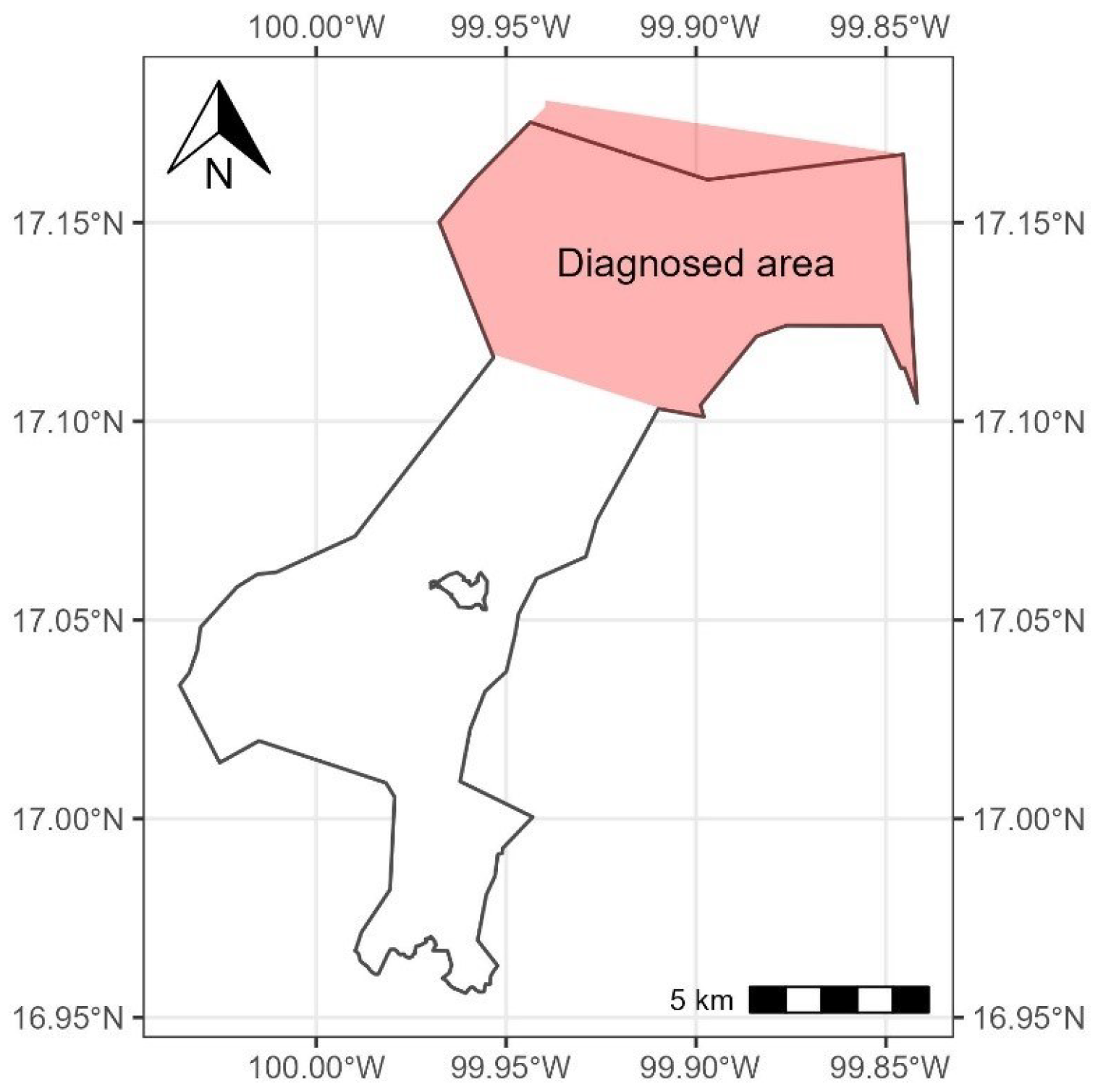
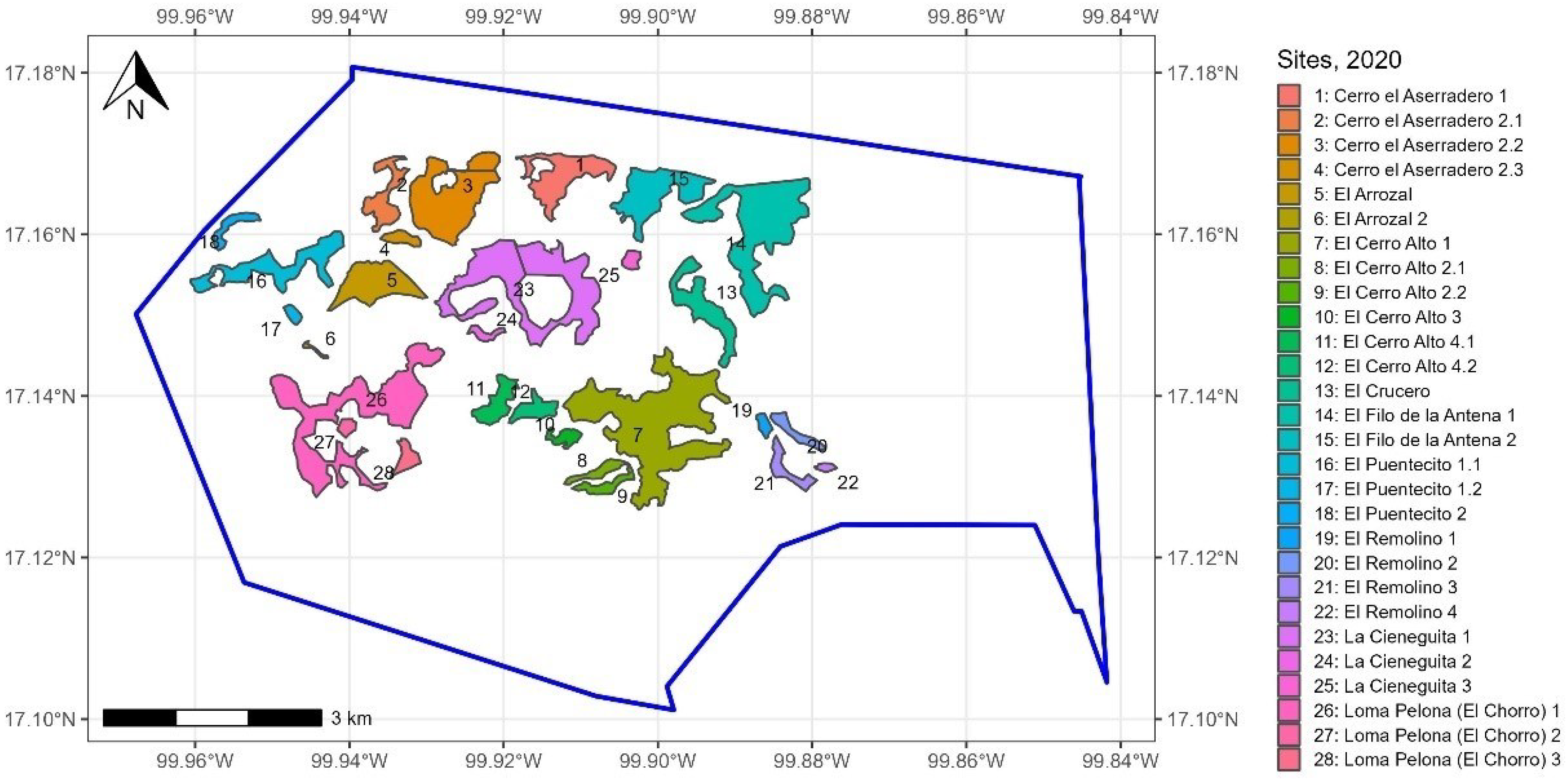
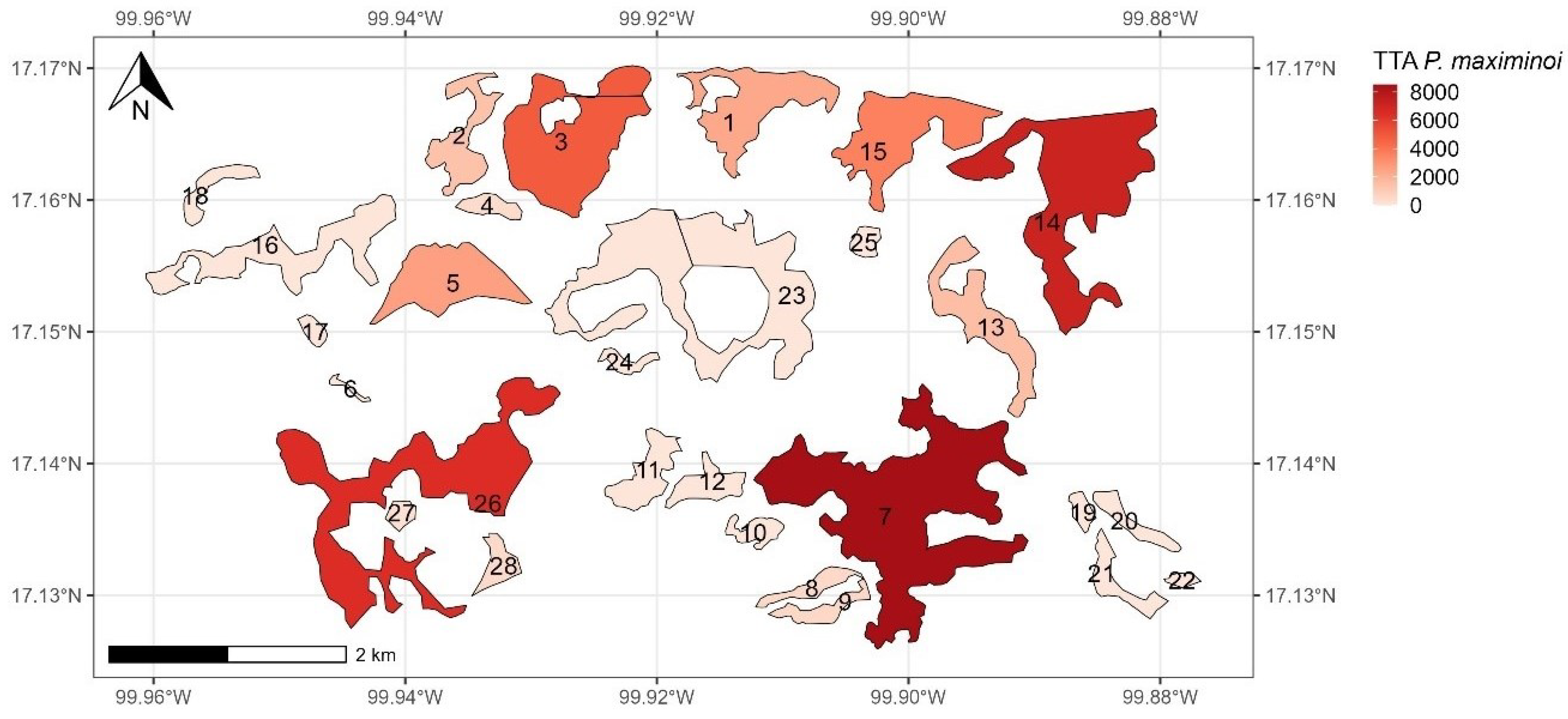
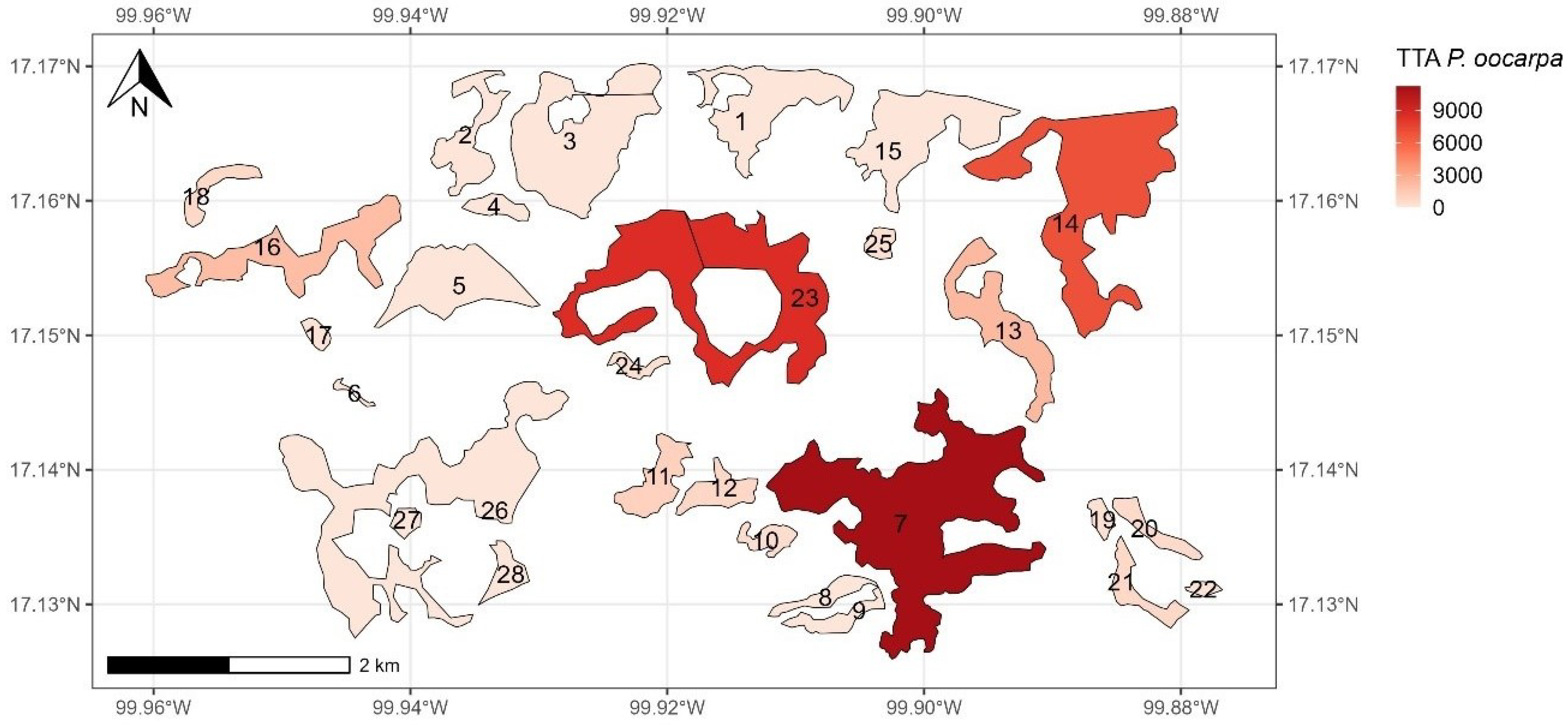
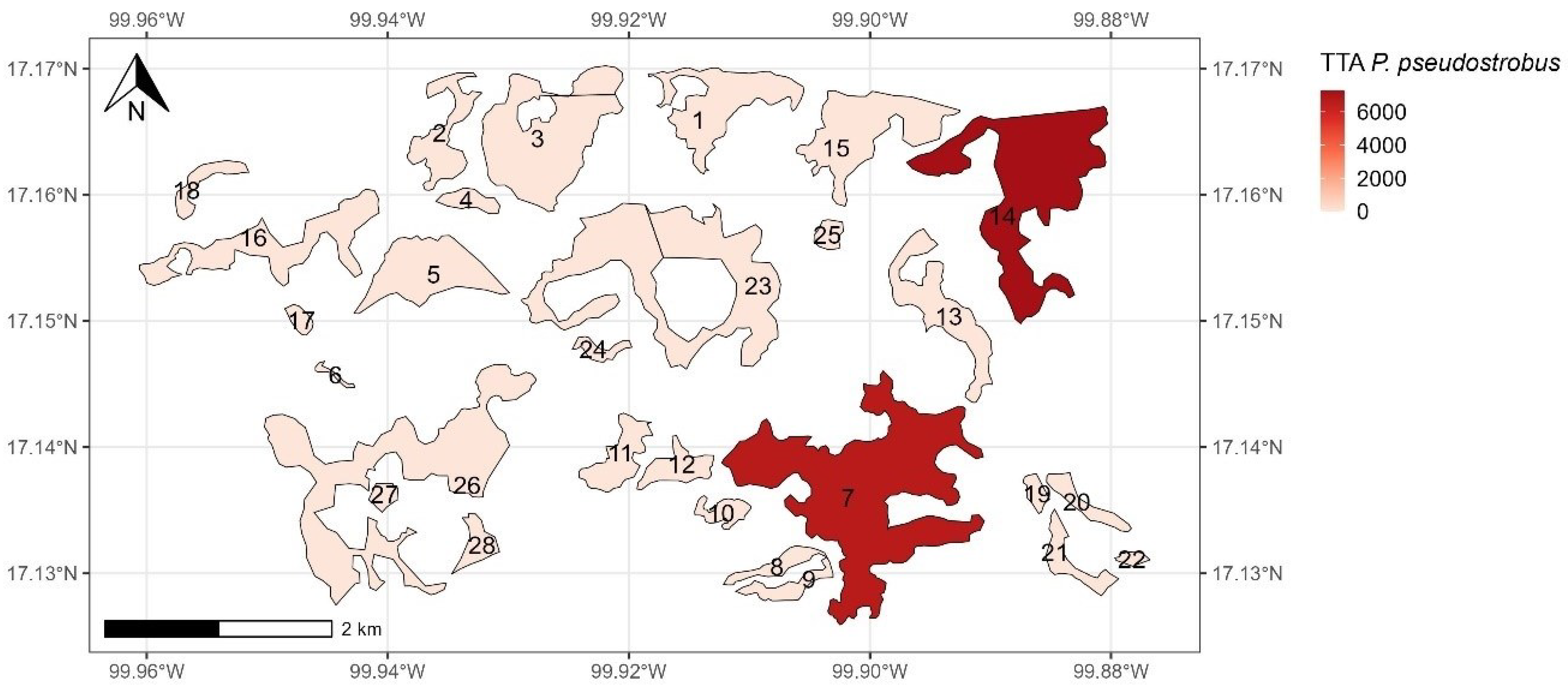
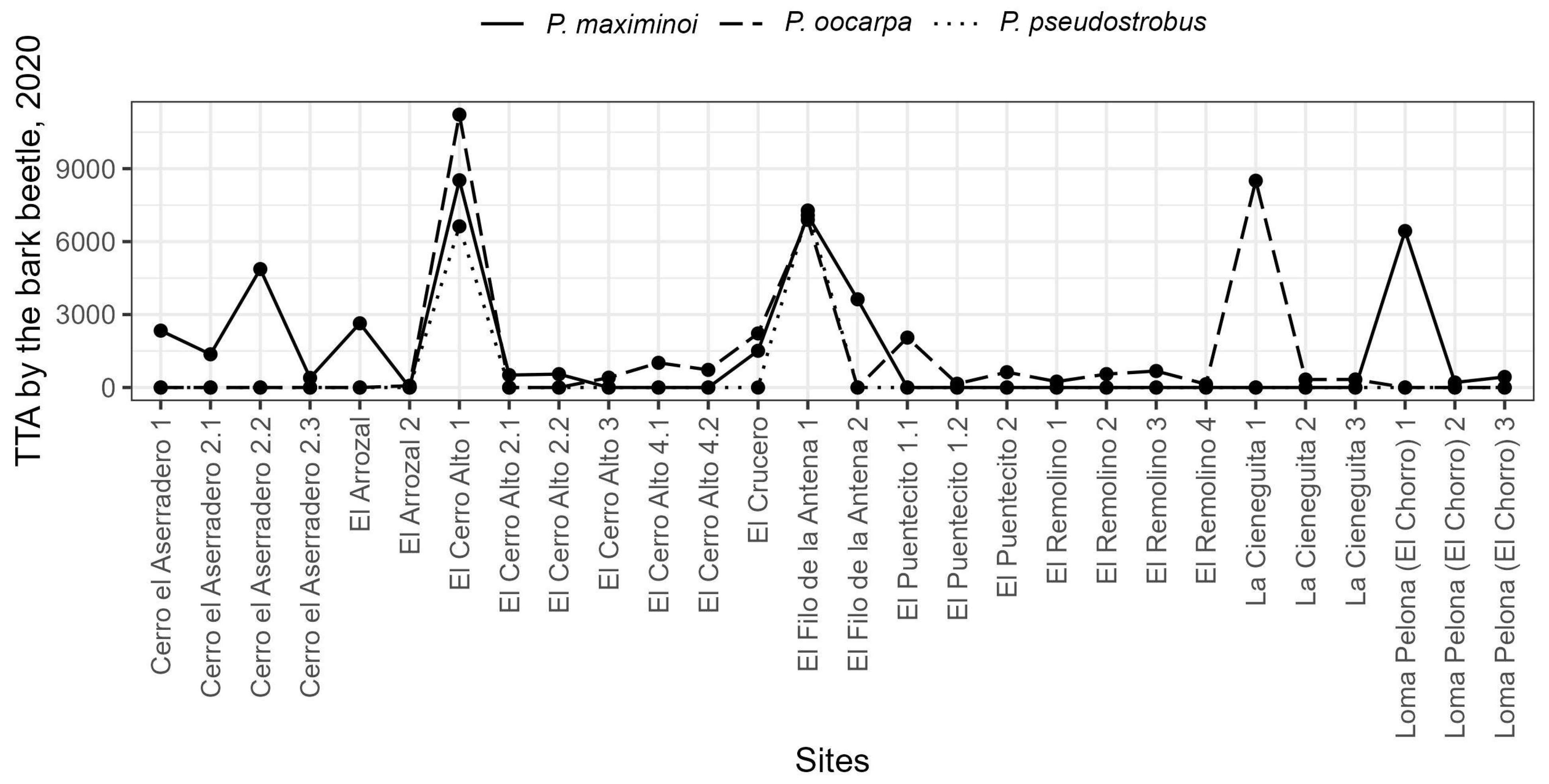
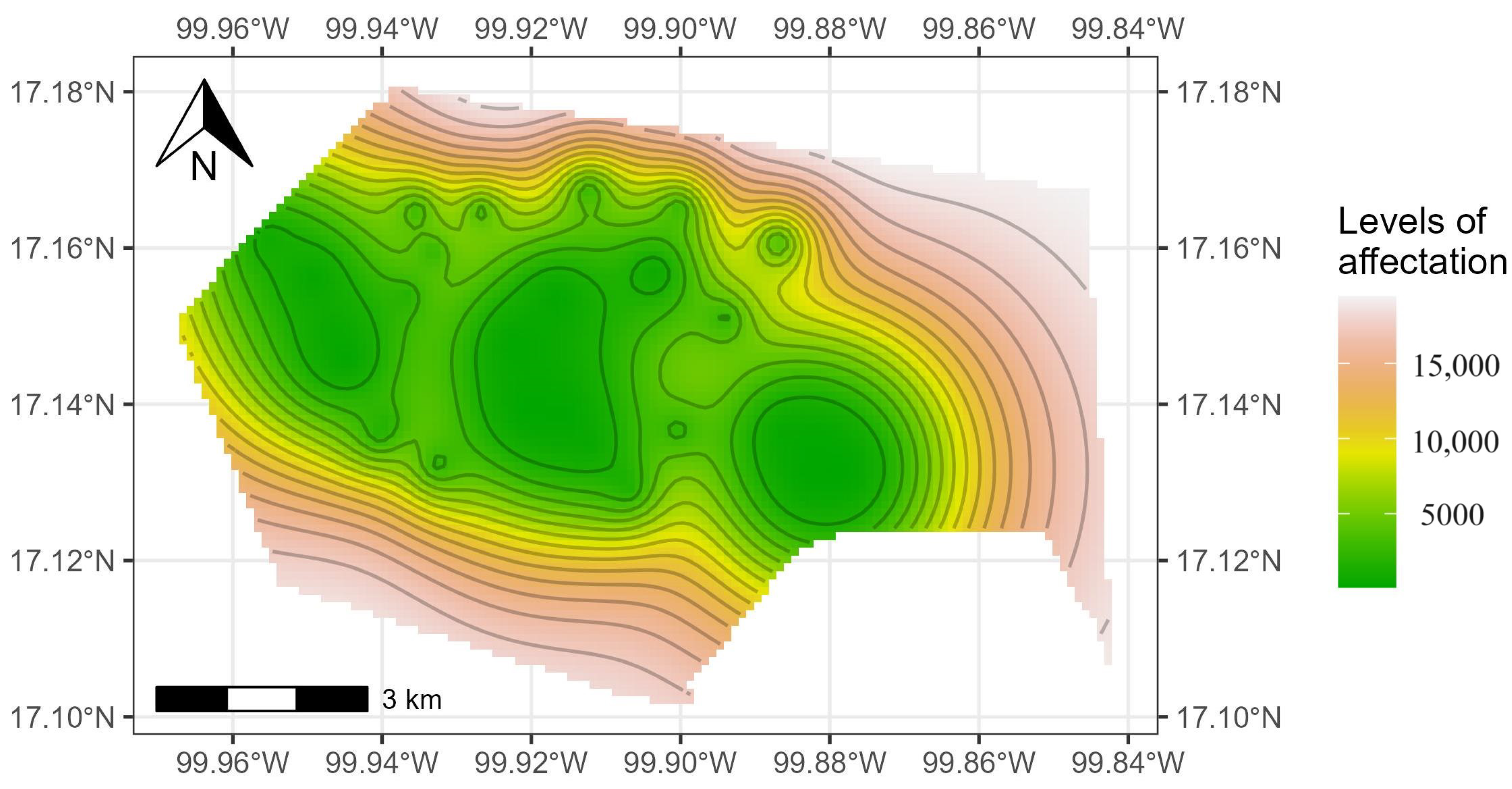
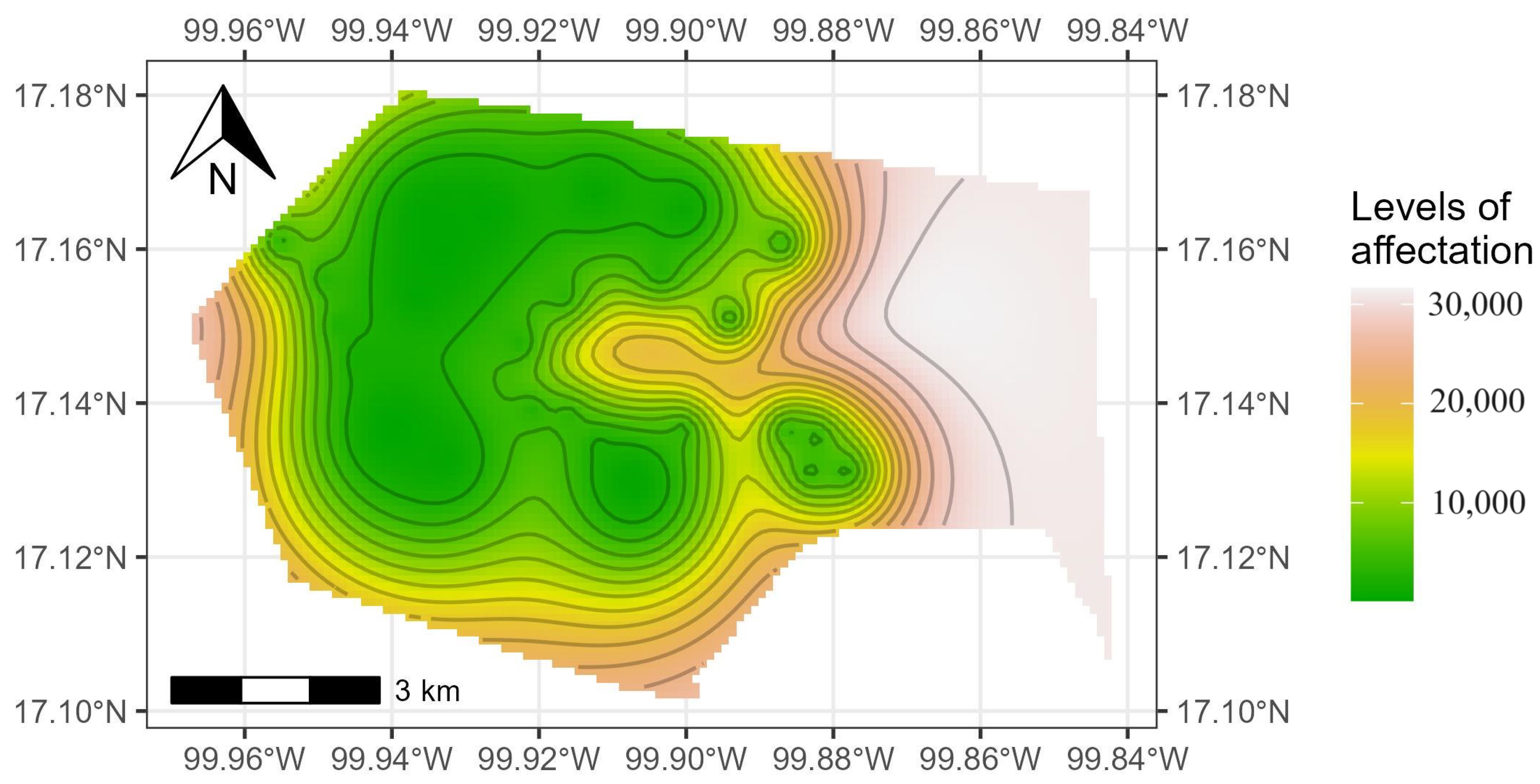

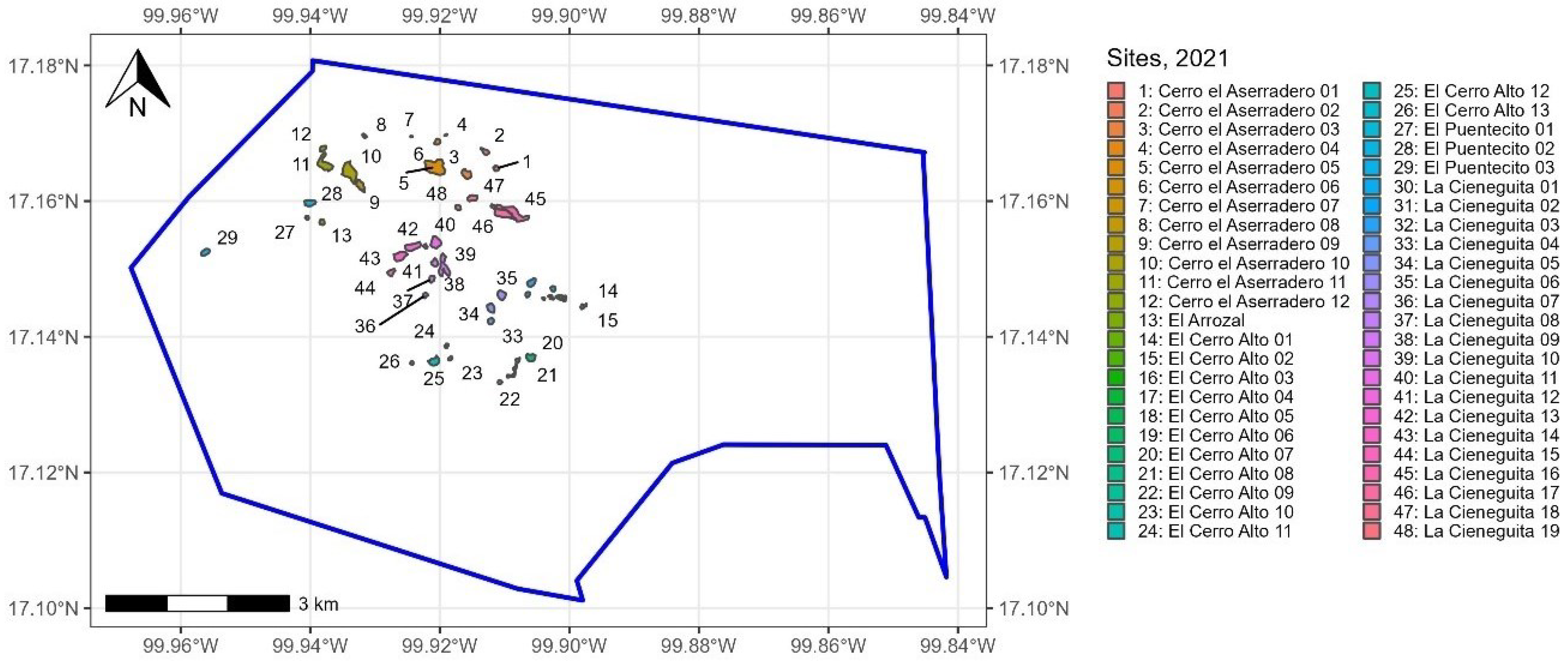
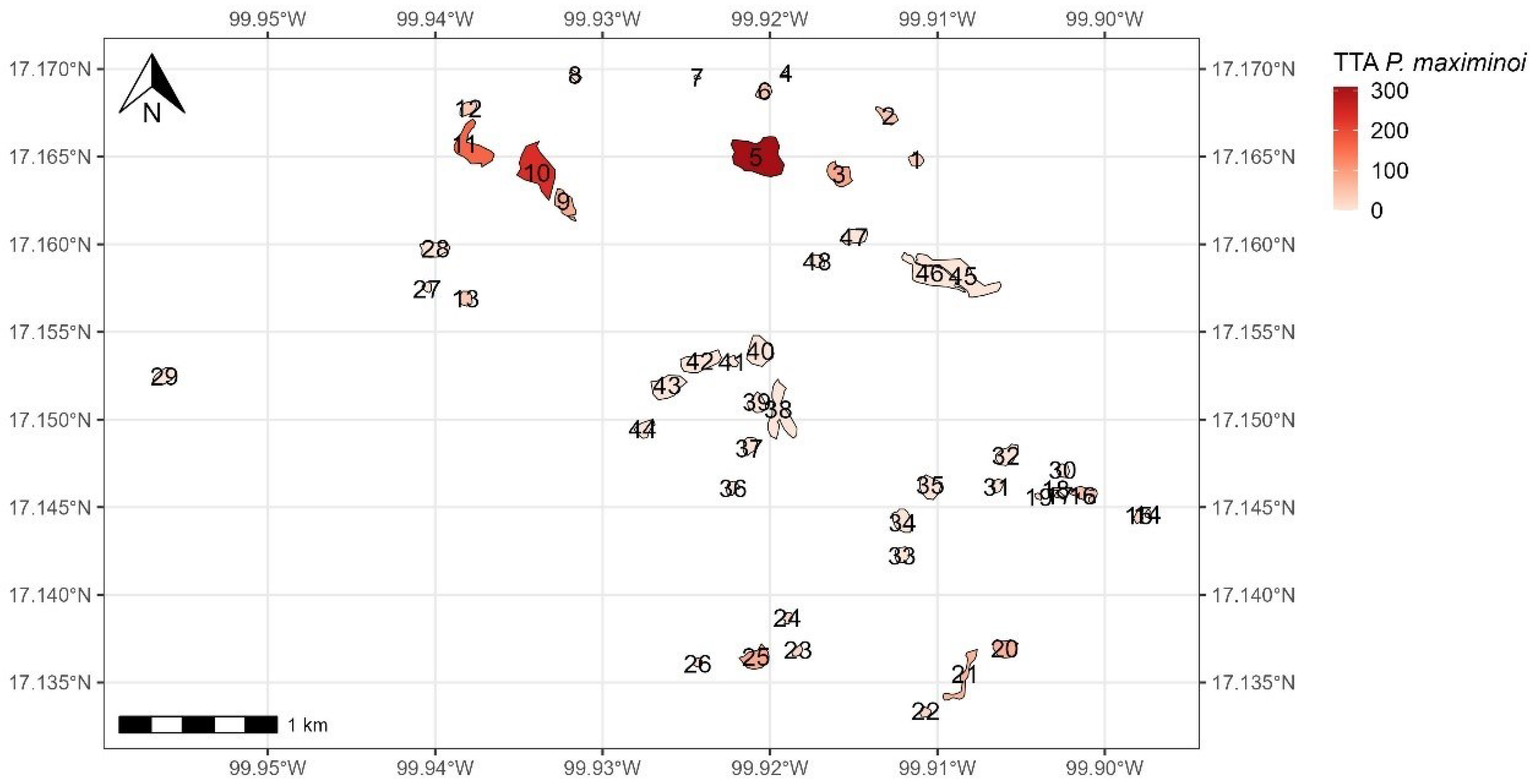
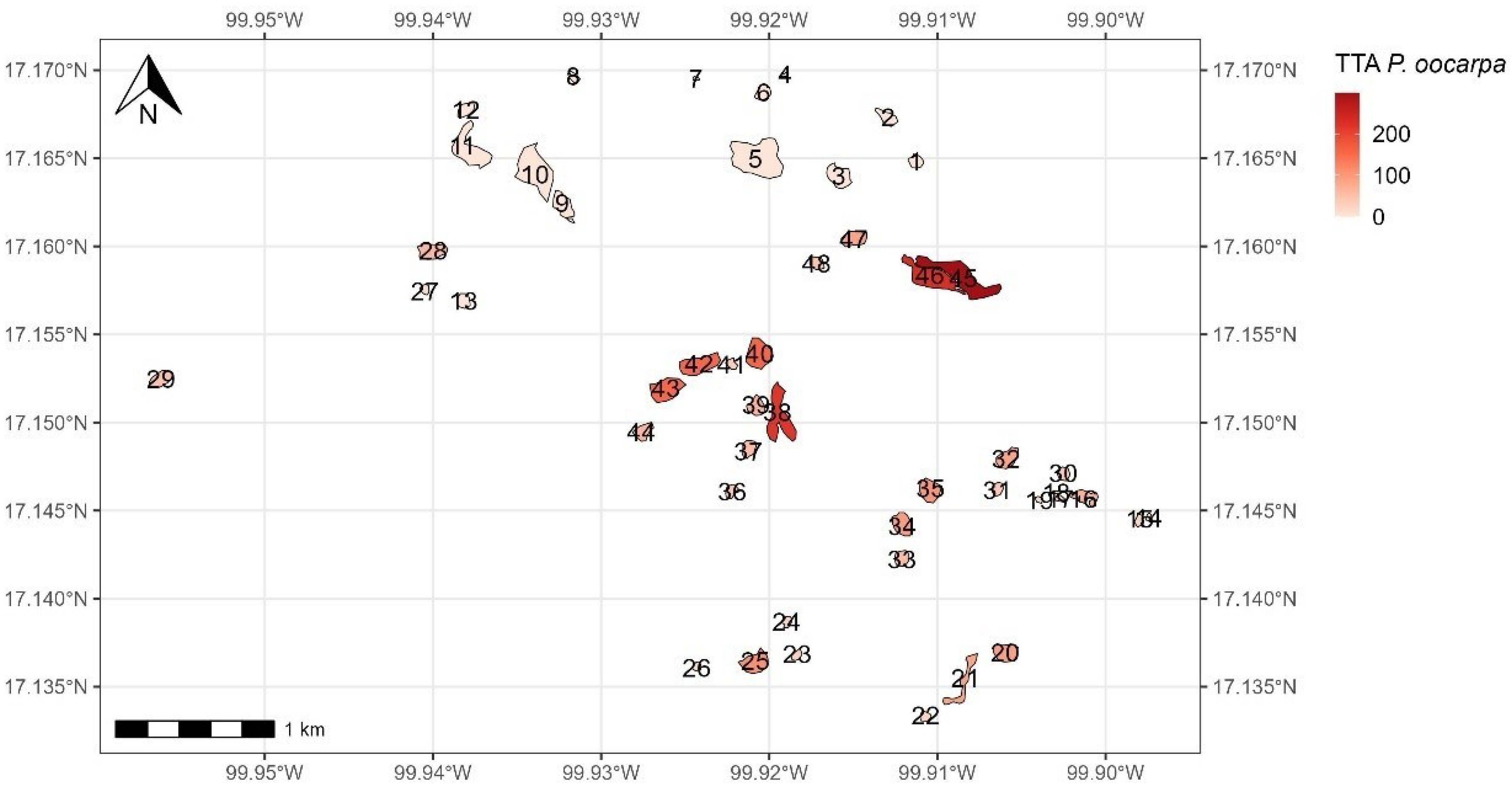
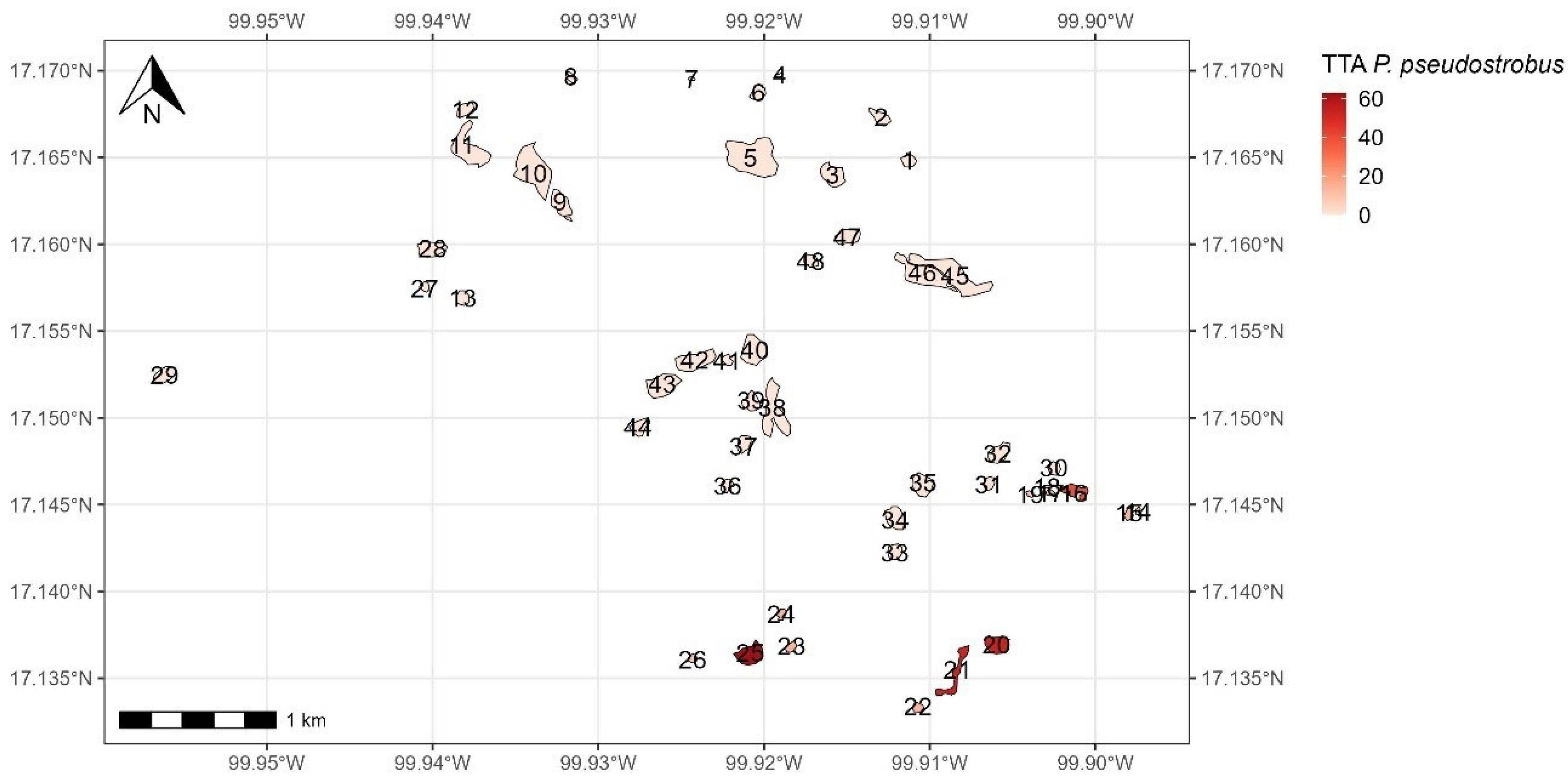
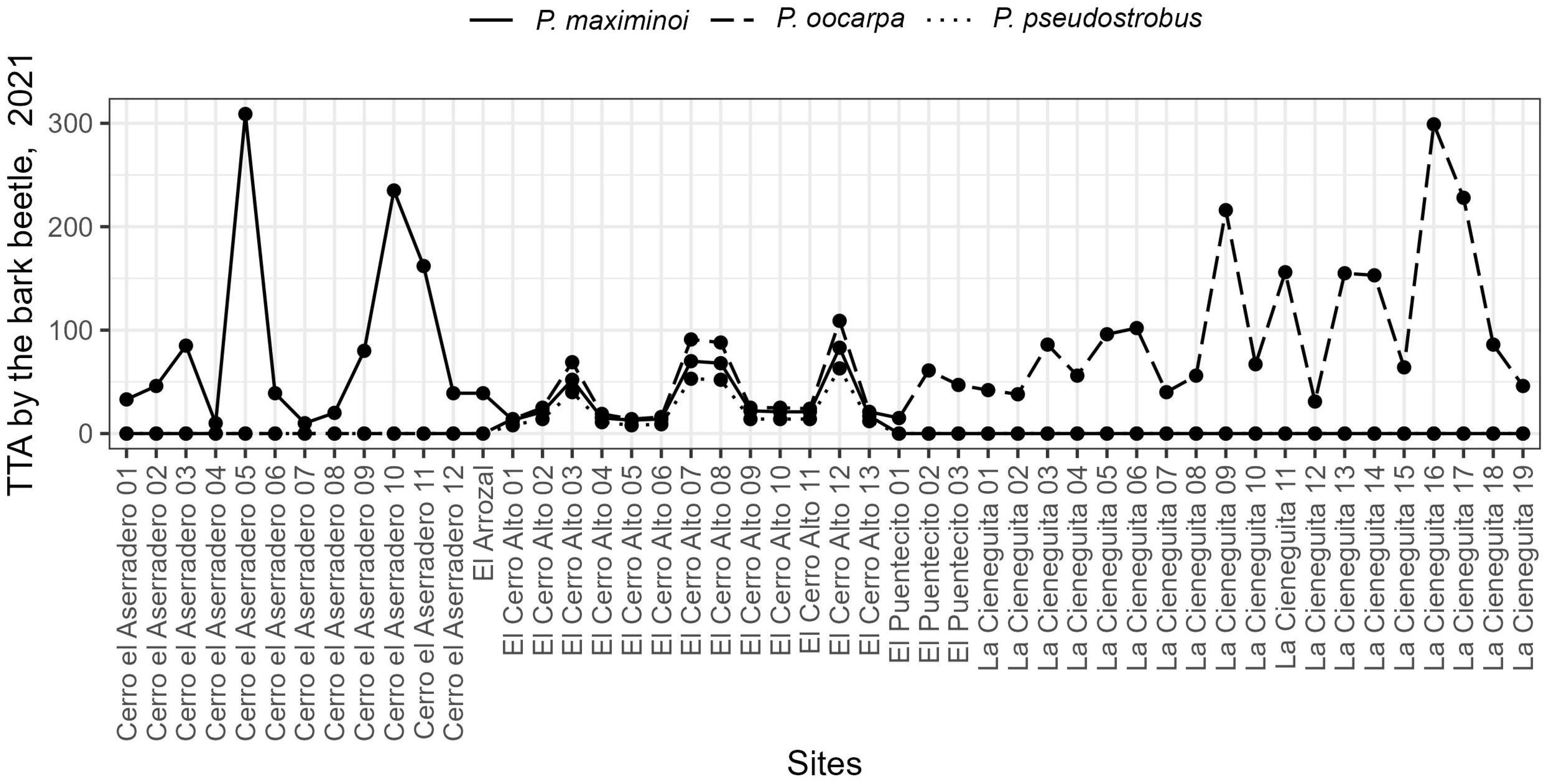
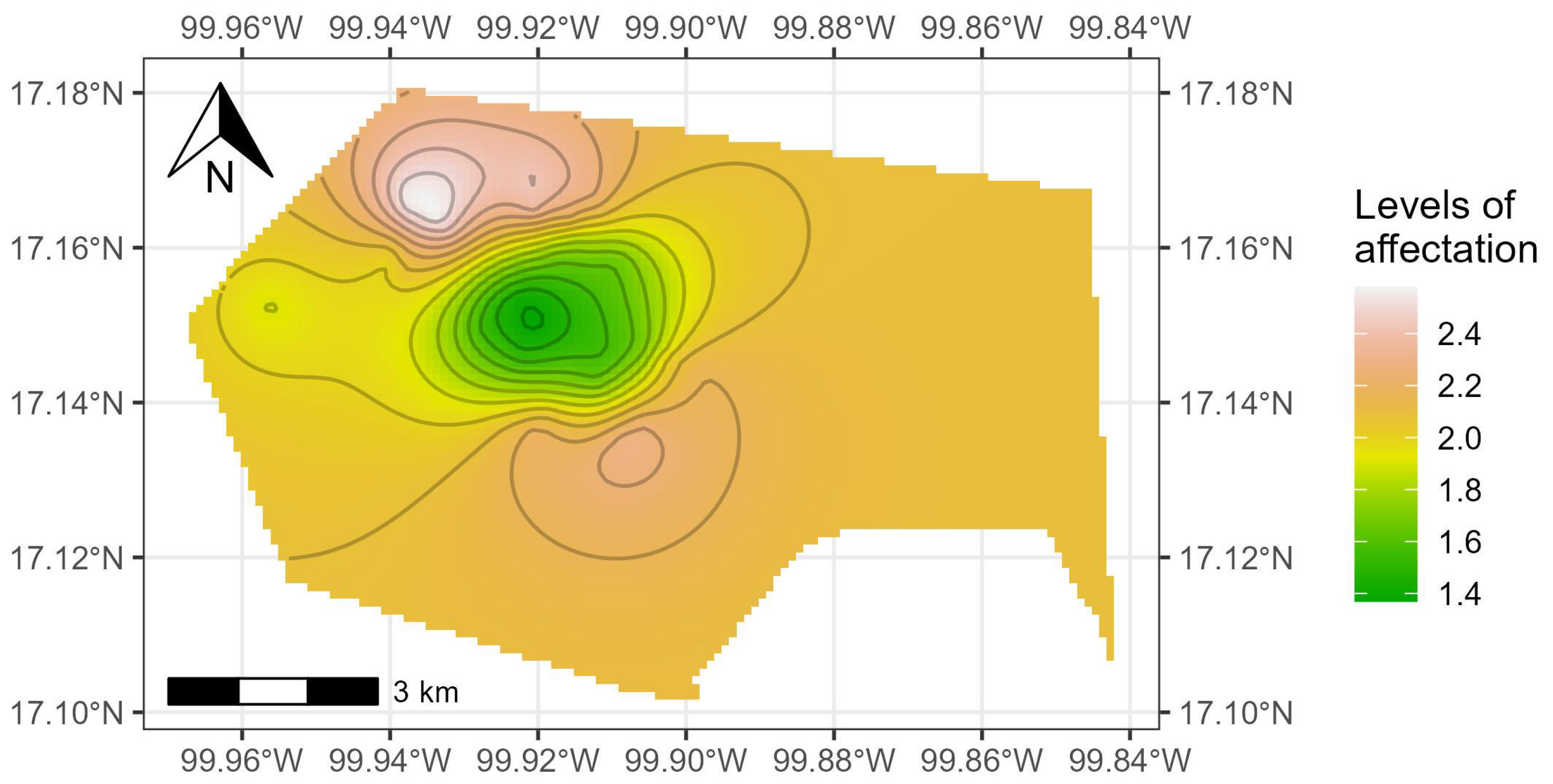
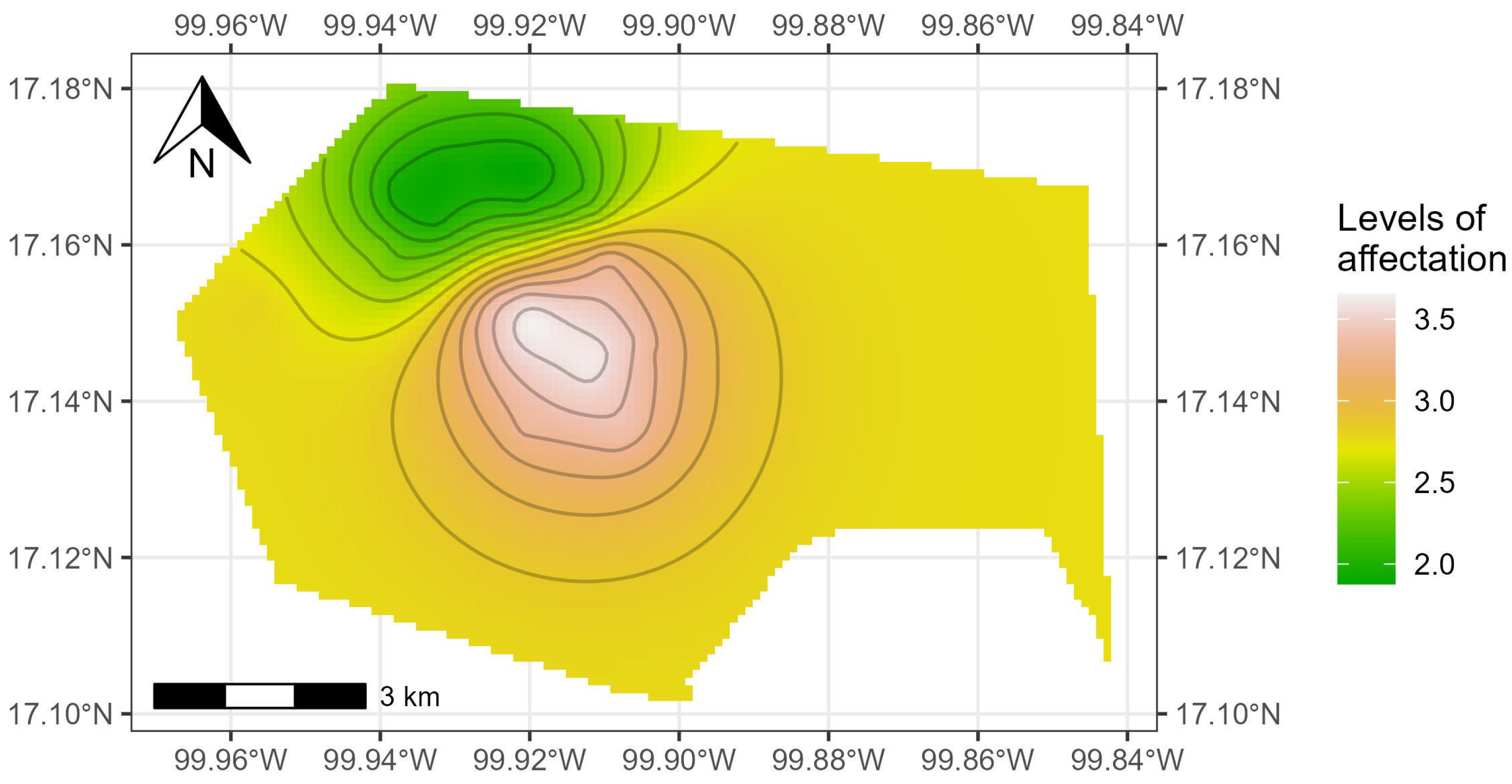
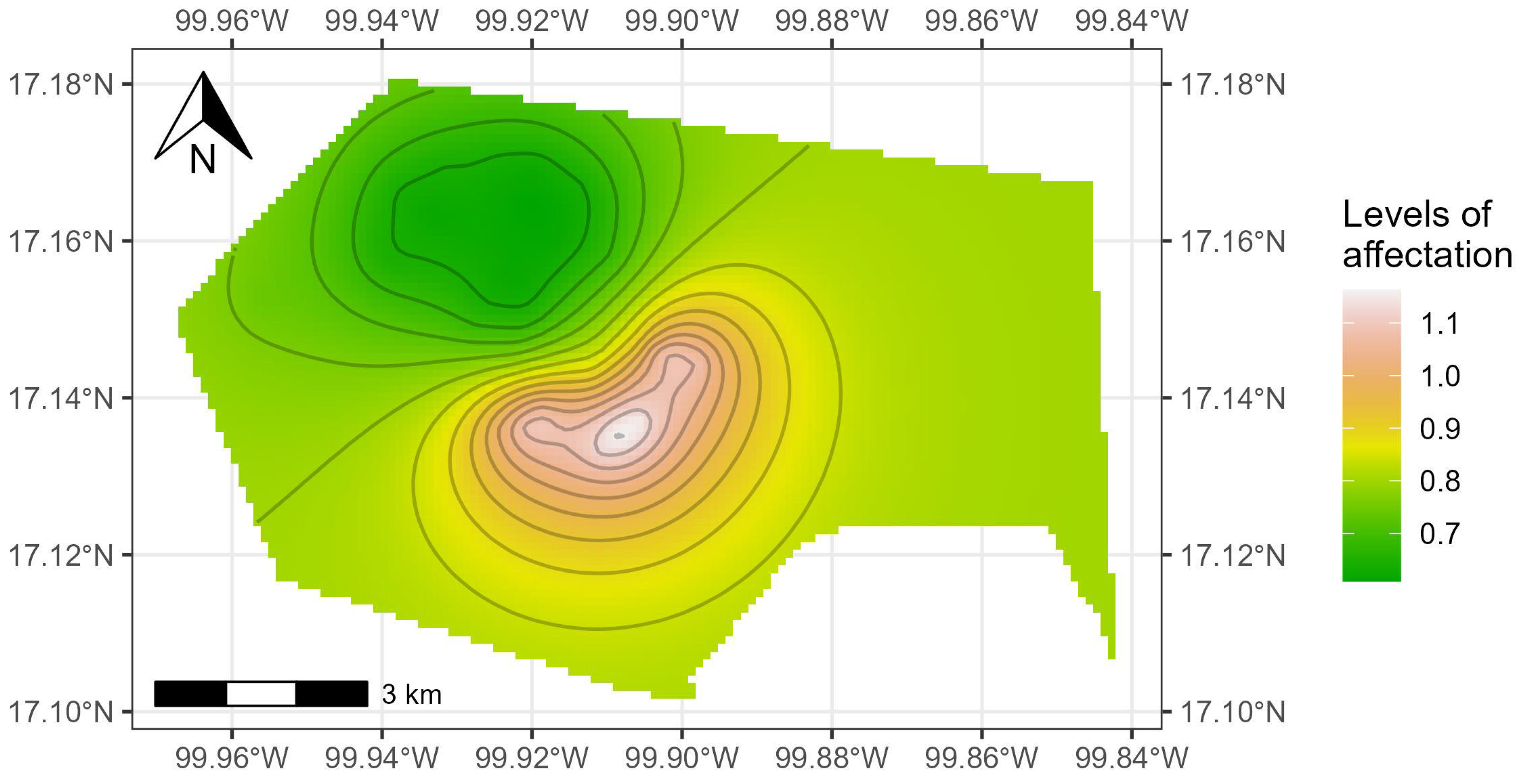
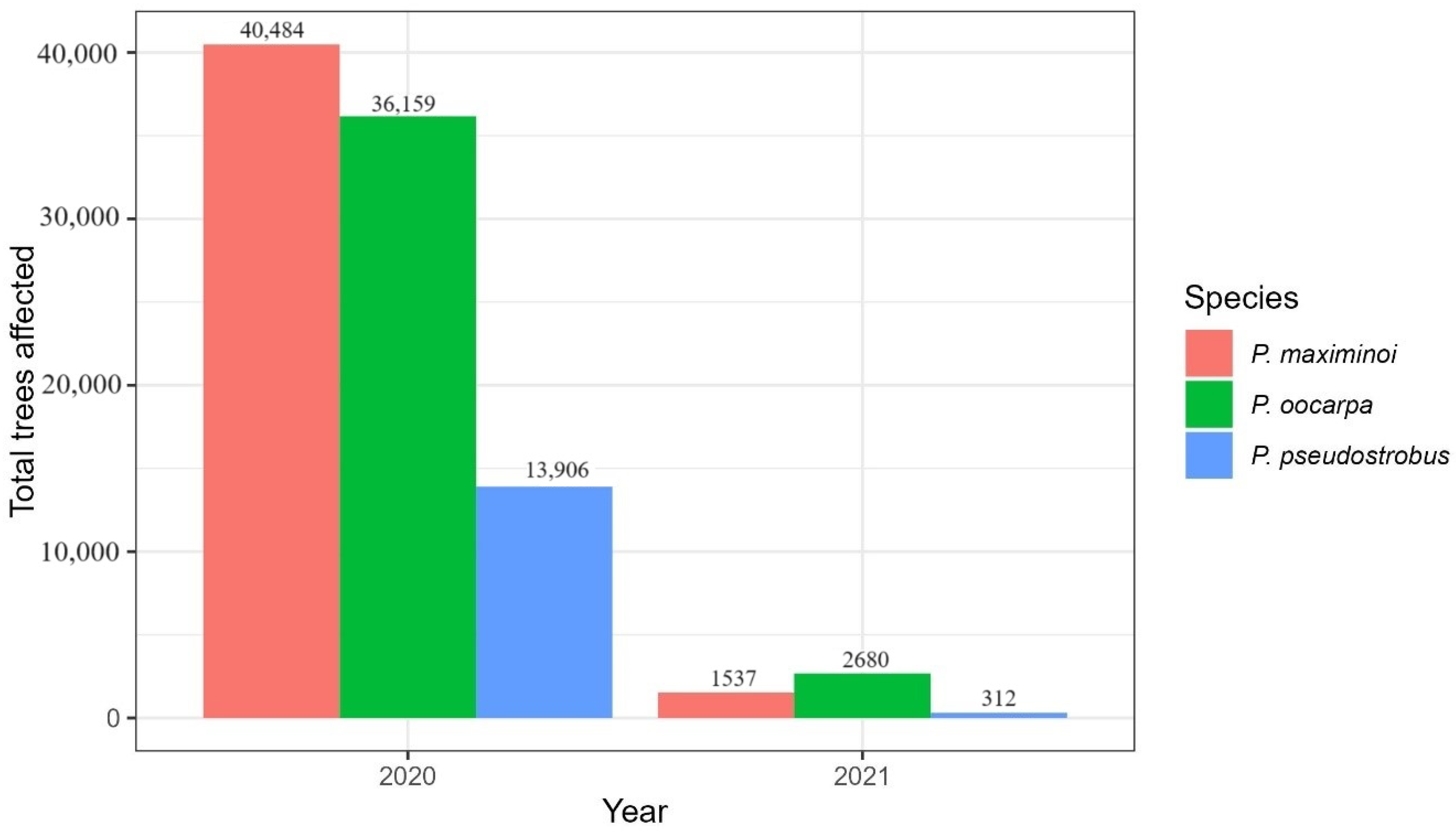
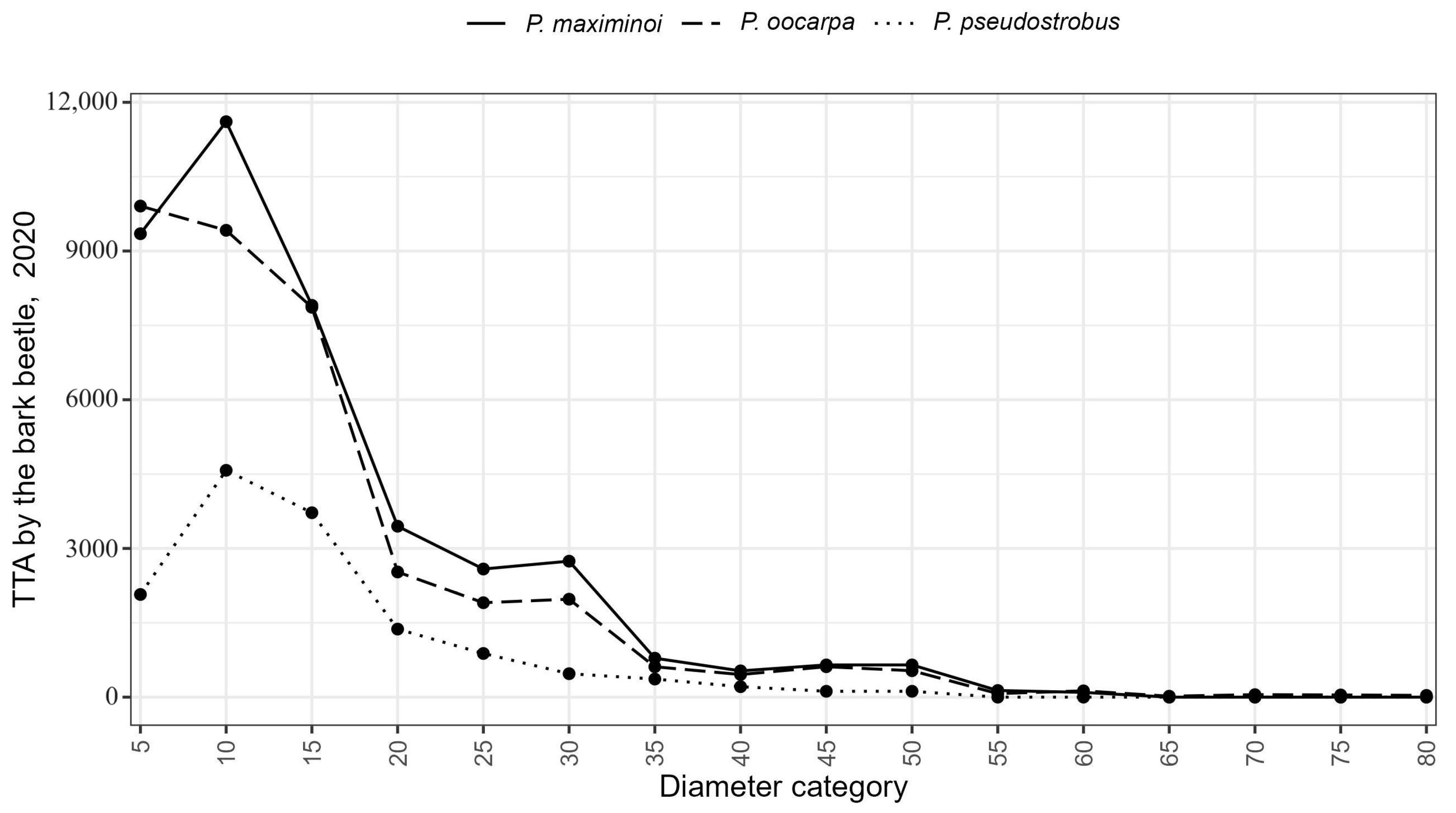
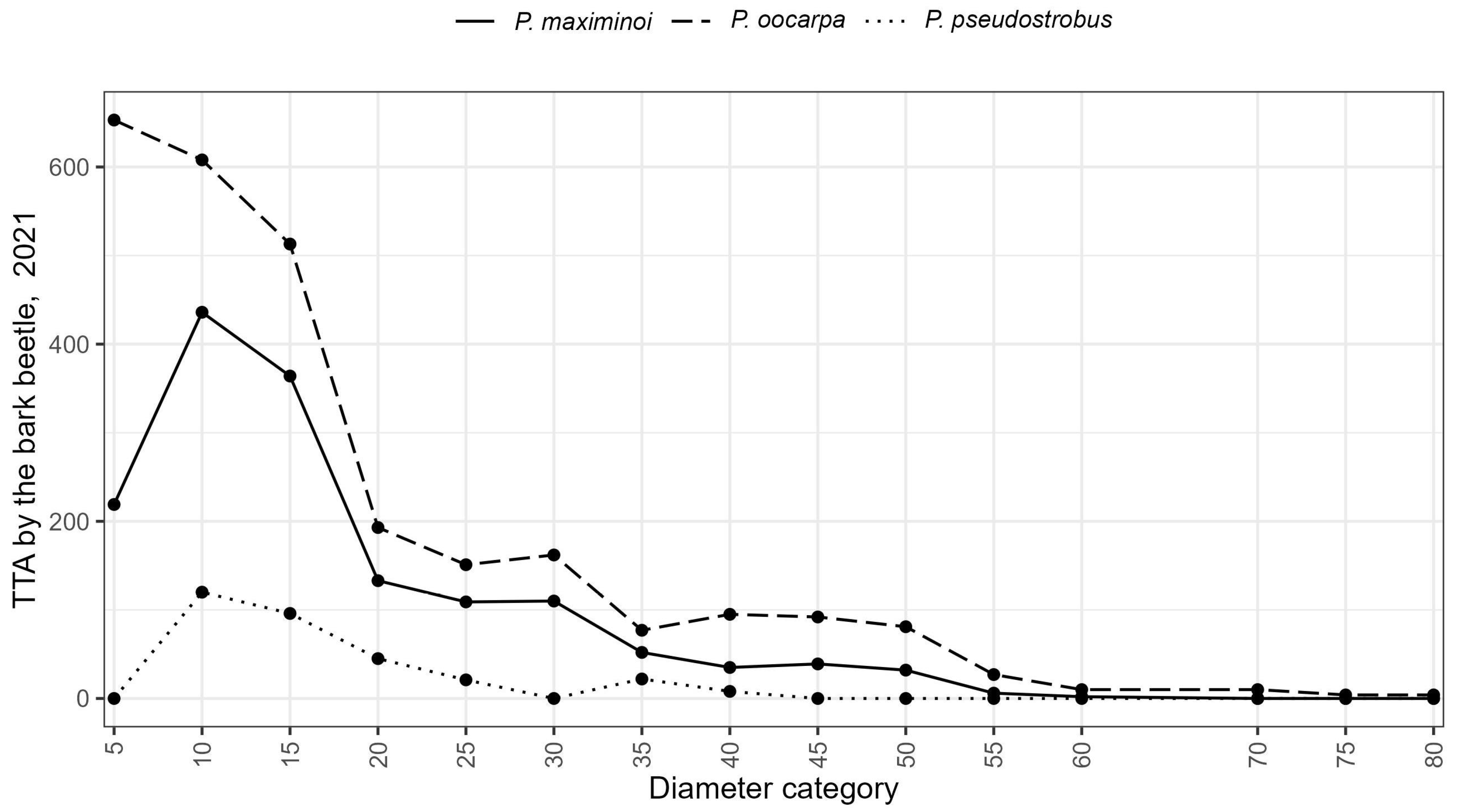
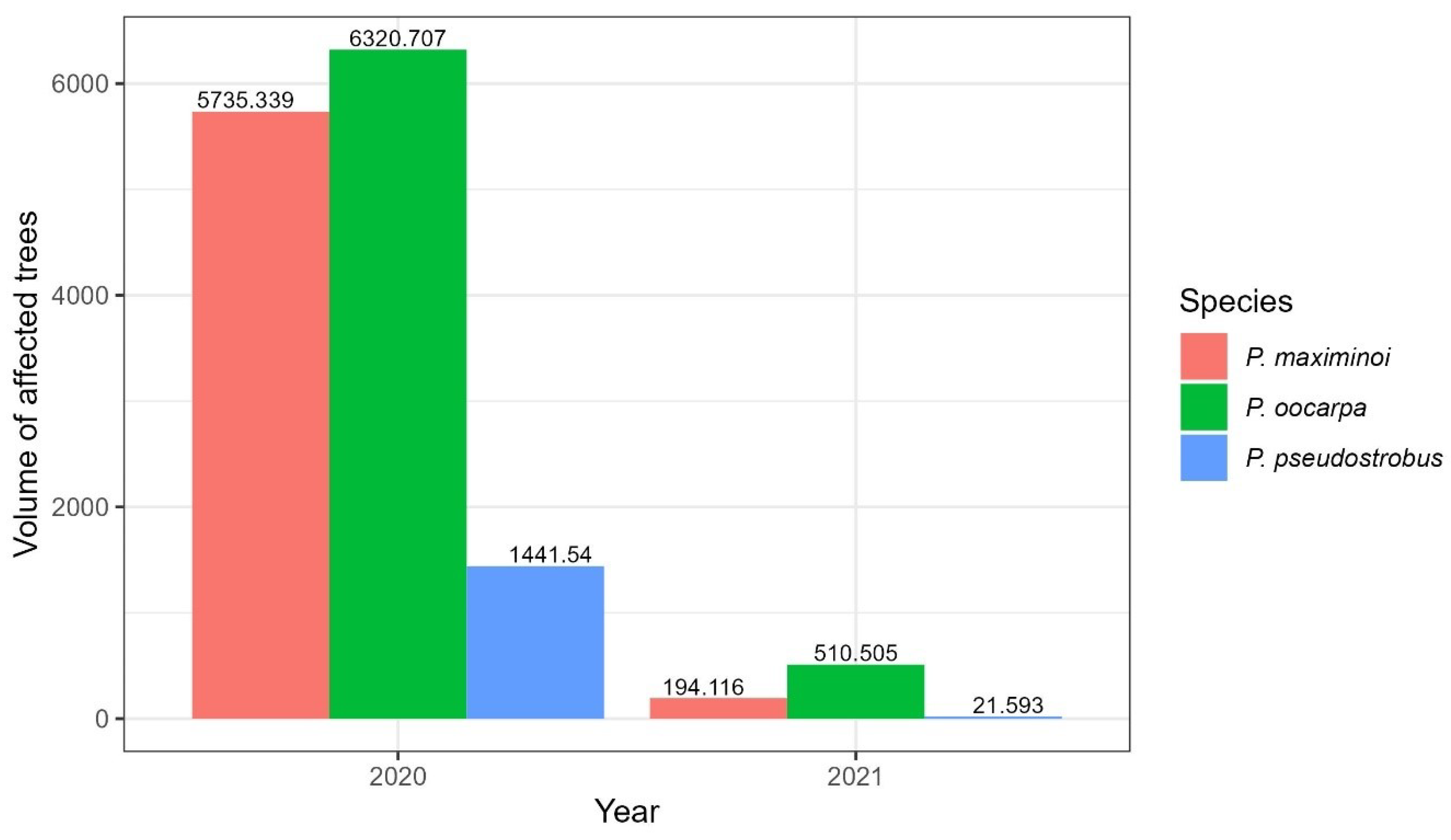
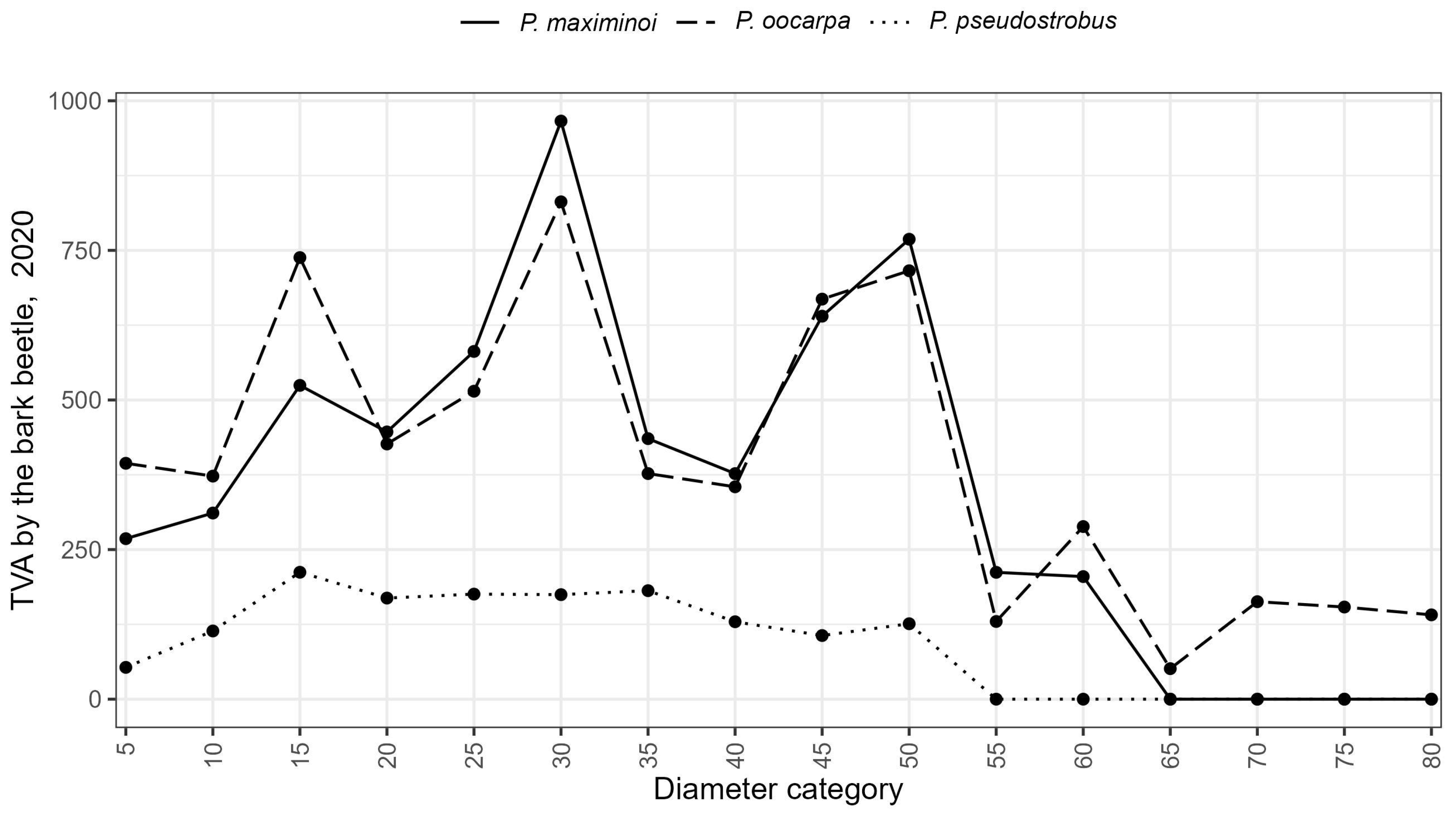
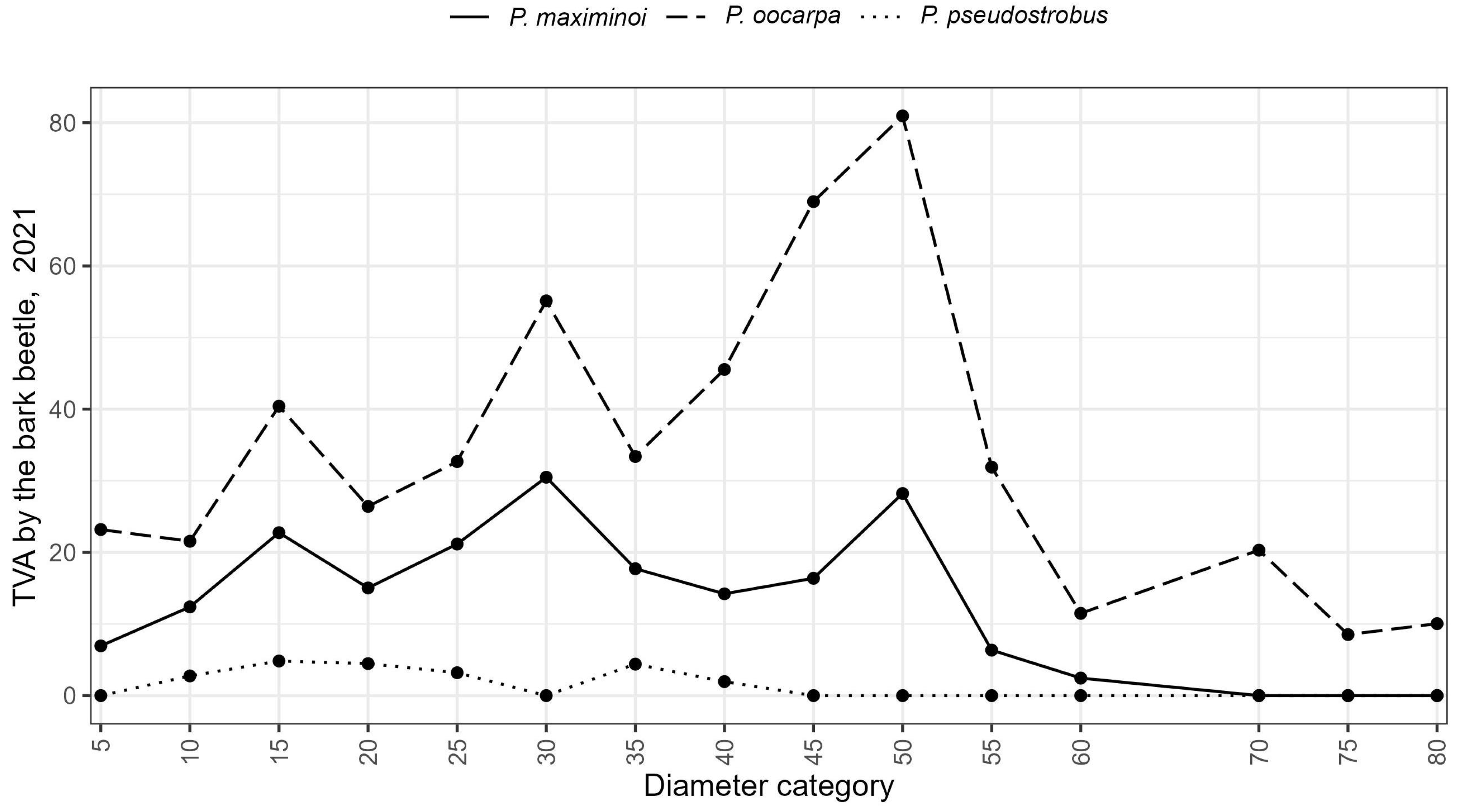
| Factors | Average April | Average May | Average June |
|---|---|---|---|
| Precipitation (mm) | 0.000 | 0.000 | 5.443 |
| Air temperature (°C) | 26.233 | 24.839 | 27.800 |
| Minimum temperature (°C) | 24.733 | 23.613 | 26.633 |
| Maximum temperature (°C) | 31.300 | 30.935 | 31.867 |
| Factors | Average April | Average May | Average June | Year |
|---|---|---|---|---|
| Air temperature (°C) | 26.907 | 27.525 | 28.780 | 2020 |
| Air temperature (°C) | 26.997 | 28.720 | 27.139 | 2021 |
| Minimum precipitation (mm) | 0.000 | 0.006 | 0.131 | 2021 |
| Species | No. Trees | Volume ( t.t.v.) | No. Trees | Volume ( t.t.v.) |
|---|---|---|---|---|
| Year 2020 | Year 2021 | |||
| P. maximinoi | 40,484 (44.7%) | 5735.34 (42.5%) | 1537 (33.9%) | 194.12 (26.7%) |
| P. oocarpa | 36,159 (39.9%) | 6320.71 (46.8%) | 2680 (59.2%) | 510.50 (70.3%) |
| P. pseudostrobus | 13,906 (15.4%) | 1441.54 (10.7%) | 312 (6.9%) | 21.59 (3.0%) |
| Total | 90,549 | 13,497.59 | 4529 | 726.21 |
| Ejido Tixtlancingo | Diagnostic 2020 | Diagnostic 2021 | |
|---|---|---|---|
| Outbreaks presented | 28 | 48 | |
| Affected surface (ha) | 1057.64 | 60.057 | |
| Affected trees | P. maximinoi | 40,484 | 1537 |
| P. oocarpa | 36,159 | 2680 | |
| P. pseudostrobus | 13,906 | 312 | |
| Affected volume ( t.t.v.) | P. maximinoi | 5735.339 | 194.116 |
| P. oocarpa | 6320.707 | 510.505 | |
| P. pseudostrobus | 1441.54 | 21.593 | |
| CD | TTA 2020 | TVA 2020 | TTA 2021 | TVA 2021 |
|---|---|---|---|---|
| 5 | 21,327 | 715.578 | 872 | 30.135 |
| 10 | 25,603 | 797.770 | 1164 | 36.688 |
| 15 | 19,489 | 1474.452 | 973 | 67.993 |
| 20 | 7346 | 1042.056 | 371 | 45.924 |
| 25 | 5371 | 1271.337 | 281 | 57.046 |
| 30 | 5192 | 1971.889 | 272 | 85.615 |
| 35 | 1764 | 993.746 | 151 | 55.500 |
| 40 | 1197 | 861.229 | 138 | 61.714 |
| 45 | 1382 | 1414.892 | 131 | 85.359 |
| 50 | 1301 | 1610.640 | 113 | 109.167 |
| 55 | 206 | 341.814 | 33 | 38.259 |
| 60 | 223 | 493.336 | 12 | 13.934 |
| 65 | 19 | 51.014 | - | - |
| 70 | 50 | 162.925 | 10 | 20.309 |
| 75 | 44 | 153.981 | 4 | 8.522 |
| 80 | 35 | 140.927 | 4 | 10.049 |
| Total | 90,549 | 13,497.59 | 4529 | 726.214 |
Disclaimer/Publisher’s Note: The statements, opinions and data contained in all publications are solely those of the individual author(s) and contributor(s) and not of MDPI and/or the editor(s). MDPI and/or the editor(s) disclaim responsibility for any injury to people or property resulting from any ideas, methods, instructions or products referred to in the content. |
© 2024 by the authors. Licensee MDPI, Basel, Switzerland. This article is an open access article distributed under the terms and conditions of the Creative Commons Attribution (CC BY) license (https://creativecommons.org/licenses/by/4.0/).
Share and Cite
Avila-Pérez, H.; Guzmán-Martínez, M.; Rosas-Acevedo, J.L.; Navarro-Martínez, J.; Gallardo-Bernal, I. Study of the Spatial Distribution of the Bark Beetle in the Ejido Tixtlancingo. Forests 2024, 15, 916. https://doi.org/10.3390/f15060916
Avila-Pérez H, Guzmán-Martínez M, Rosas-Acevedo JL, Navarro-Martínez J, Gallardo-Bernal I. Study of the Spatial Distribution of the Bark Beetle in the Ejido Tixtlancingo. Forests. 2024; 15(6):916. https://doi.org/10.3390/f15060916
Chicago/Turabian StyleAvila-Pérez, Humberto, María Guzmán-Martínez, José L. Rosas-Acevedo, José Navarro-Martínez, and Iván Gallardo-Bernal. 2024. "Study of the Spatial Distribution of the Bark Beetle in the Ejido Tixtlancingo" Forests 15, no. 6: 916. https://doi.org/10.3390/f15060916
APA StyleAvila-Pérez, H., Guzmán-Martínez, M., Rosas-Acevedo, J. L., Navarro-Martínez, J., & Gallardo-Bernal, I. (2024). Study of the Spatial Distribution of the Bark Beetle in the Ejido Tixtlancingo. Forests, 15(6), 916. https://doi.org/10.3390/f15060916







